

Legacy immortalized in the rafters
Caitlin Clark’s jersey retirement celebrates her impact on basketball.
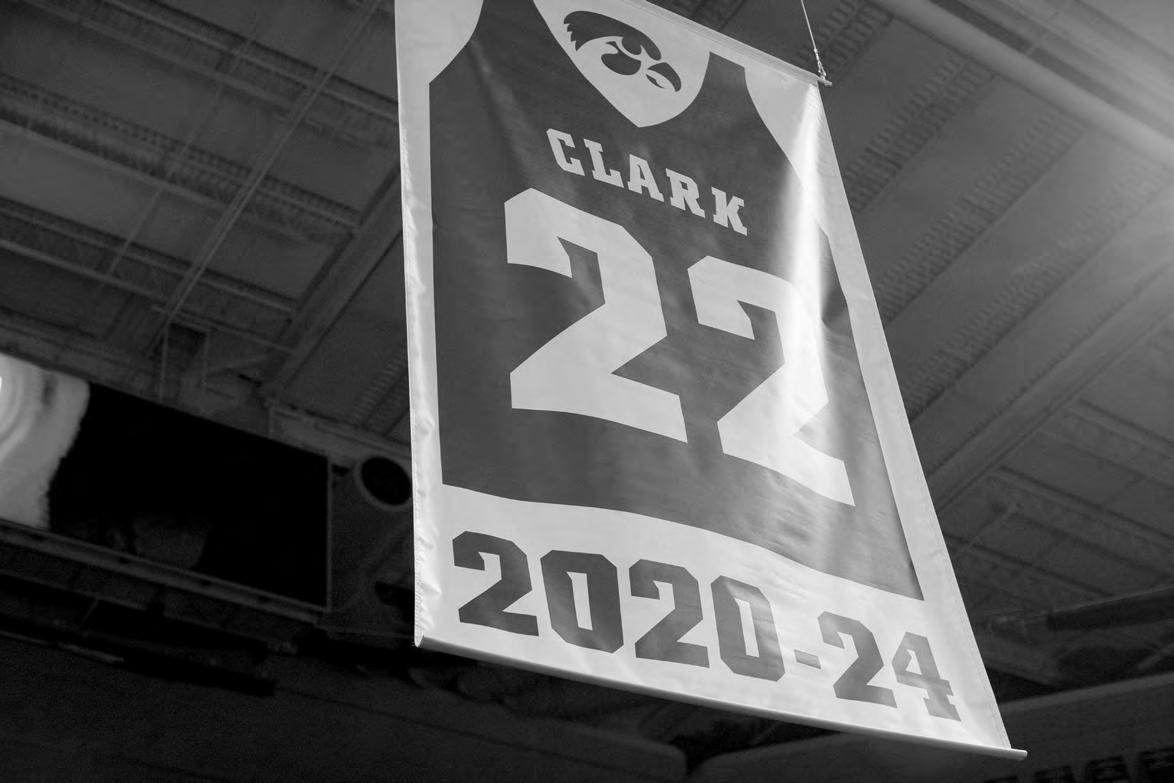
Colin Votzmeyer
Just a few years ago, former Iowa women’s basketball head coach Lisa Bluder strolled into Carver-Hawk eye Arena before practice to Caitlin Clark getting shots up. She stopped to watch the star player take a moment to look up at the jerseys in the rafters.
“Caitlin, someday your name is going to be up there,” Bluder told Clark.
That day has finally come.
The University of Iowa Athletics Department first announced on Dec. 18 that Clark’s No. 22 jersey would be retired in the rafters of Carver-Hawkeye Arena, coincid ing with Iowa women’s basketball’s contest with the fourth-ranked USC Trojans on Feb. 2.
Joining Megan Gustafson’s No. 10 in 2020 and Michelle Edwards’ No. 30 in 1990, Clark’s jersey retire ment immortalizes her in Hawkeye hoops history.

“I’m forever proud to be a Hawkeye, and Iowa holds a special place in my heart that is bigger than just basketball,” Clark said in the announcement. “It means the world to me to receive this honor and to celebrate it with my family, friends and alumni. It will be a great feeling to look up in the rafters and see my jersey alongside those that I’ve admired for so long.”
The recognition is undoubtedly deserved, as Clark has been the fire beneath the explosion of women’s basketball over the last two years.
“Caitlin Clark has not only redefined excellence on the court but has also inspired countless young athletes to pursue their dreams with passion and determination,” UI athletics director Beth Goetz said in the announcement. “Retiring her number is a testament to her extraordinary contributions and a celebration of her legacy that will continue to inspire future generations. Hawkeye fans are eager to say thank you for so many incredible moments.”
Following a 76-69 upset win over USC and a miniature court storm from the Hawkeye students came two tribute videos — a short, heartfelt documentary with voiceovers from Clark and Bluder and a hype tape squeezing in as many Clark highlights as possible within a 150-second frame.
From there, she walked from the Iowa bench through a tunnel formed by the team out to center court where the sold-out crowd showered her with a well-deserved standing ovation. She was met by Bluder and current head coach Jan Jensen — the two coaches who won the “recruiting wars” with Clark, snagging her from the Notre Dame Fighting Irish. From the first time they watched the then-high school freshman at Dowling Catholic High School in West Des Moines, they were all-in.
“We had a step-back three, we had a semi-shoulder shrug, and we had a little grin looking over to the bench,” Jensen recalled. “We made a pact that we were going to do everything we could to be the last ones standing. And we are so thankful that we were the last ones standing.”
But even with the great interest in
the Iowan, they couldn’t have predicted what was to come.
“She’s truly generational,” Jensen said. “She changed the world. She did all these things. And people always ask Lisa and myself, ‘Did you think she was going to be that good?’ Did we think she would become the most recognizable athlete on the planet? Probably not.”
Nonetheless, the coaching pair is eternally grateful to have had the generational talent suiting up in the black and gold — not just for her on-court heroics but for what she was able to do outside the lines.
“The positive image that you’ve brought to this basketball program, this university, this state, to women’s basketball nationally, is unmeasurable,” Bluder said to Clark. “I’ve spent my entire career trying to empower young women. That’s what this is about. You’ve done more in the last four years than anybody could imagine.”
Bluder and Jensen were replaced with Clark’s family — her mom, dad, and two brothers — at center court as they faced the baseline toward the two strings that pulled No. 22 from the floor up to the ceiling for everybody to see.
Then came Clark’s time to speak. And being the kind of person she is, she thanked any and everyone she could.
“I just want to say thank you to everybody that’s here today, first of all — it means a lot to me,” Clark said. “To all the people that have just poured into me throughout the course of my career, from the people that don’t get any recognition, from our media team to our managers, all of you that have given so much of yourselves to allow me to be who I am, thank you. I can’t say it enough. I wouldn’t be here without all of you.”
From all the broken records and the uplift in ratings across all platforms to selling out nearly all stadiums in college and becoming the immediate face of the WNBA, a city-wide celebration for a single person means something more. With it comes a sense of hope and
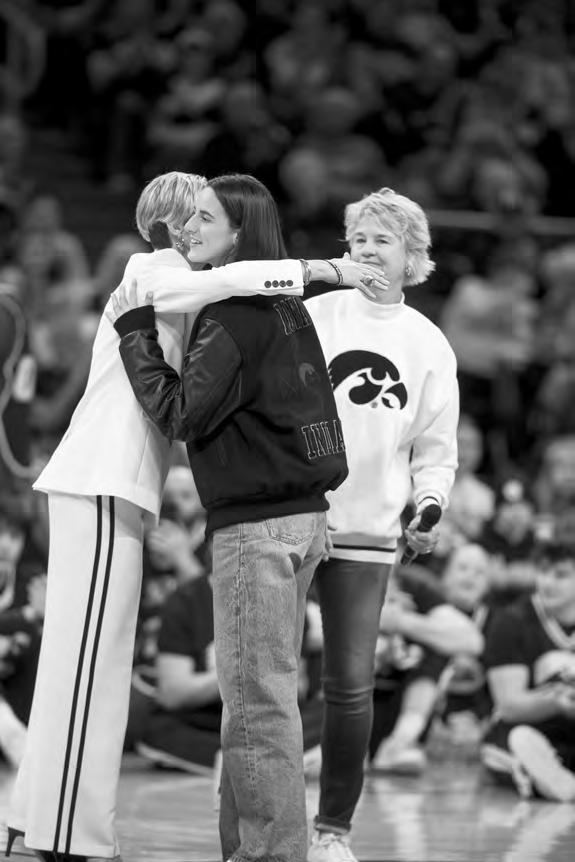
just a
to what
power for the next generation.
“I think it’s just fantastic to see the achievement of women and to see it recognized in the way that it is, and not just here in this arena but nationally,” Iowa City resident Sharon Beck said.
Joining the 15,000 Hawkeye fans watching No. 22 rise to the ceiling of Carver-Hawkeye Arena were a handful of
to be the next to add their numbers beside it. Among others, that included five- and four-star commits Addie Deal and Journey Houston, respectively, in the class of 2025 as well as five-star guard Kate Harpring in the class of 2026 — the second overall recruit in her class.
serves as the poster child of development in
basketball program, a process Jensen and assistant coach Abby Stamp can market to highly touted recruits yet to make a decision regarding their next four years of basketball.
Granted, Clark arrived in Iowa City from Dowling Catholic with boatloads of talent, leading the NCAA in scoring in her first season with 26.6 points per game.
But every recruit brings that potential to the table. Alongside the guidance from Jensen, Stamp, and former head coach Lisa Bluder, though, Clark’s perfectionist mindset around the court and never-ending push to be better turned her into something more.
When she left the court in the NCAA national championship last April, exchanging soft yet sorrowful smiles and loving hugs with her coaches on the bench, she was more than critics questioning her legacy in coming up short twice. She was a three-time Big Ten champion and two-time national runner-up. More importantly, she was the NCAA Division I all-time leading scorer — men’s or women’s. She was a two-time Naismith College Player of the Year and twotime Wooden Award winner. Her accolades take a minute or two to read.
“I will never forget her first press conference after she signed where she stated what she wanted to do, which is to take Iowa back to a Final Four,” Jensen said at media day on Oct. 10, 2024, ahead of this year’s season. “Well, she got two, right?”
And while the LSU Tigers and South Carolina Gamecocks won the NCAA titles over Clark and the Hawkeyes in backto-back seasons, it’s just that which is remembered of the explosion of women’s basketball this decade — Caitlin Clark and the Iowa Hawkeyes.
“Caitlin’s ability to empower those around her, to believe in what possibly the others didn’t think was possible, that’s what you’ll miss initially,” Jensen said.
One year later, she’s 2024’s AP Female Athlete of the Year after her rookie season with the Indiana Fever gave her WNBA All-Star, All-WNBA First Team, and WNBA Rookie of the Year nods.
In addition to the eyes now on the WNBA with Clark’s emergence, a tangible product of her impact and value comes economically.
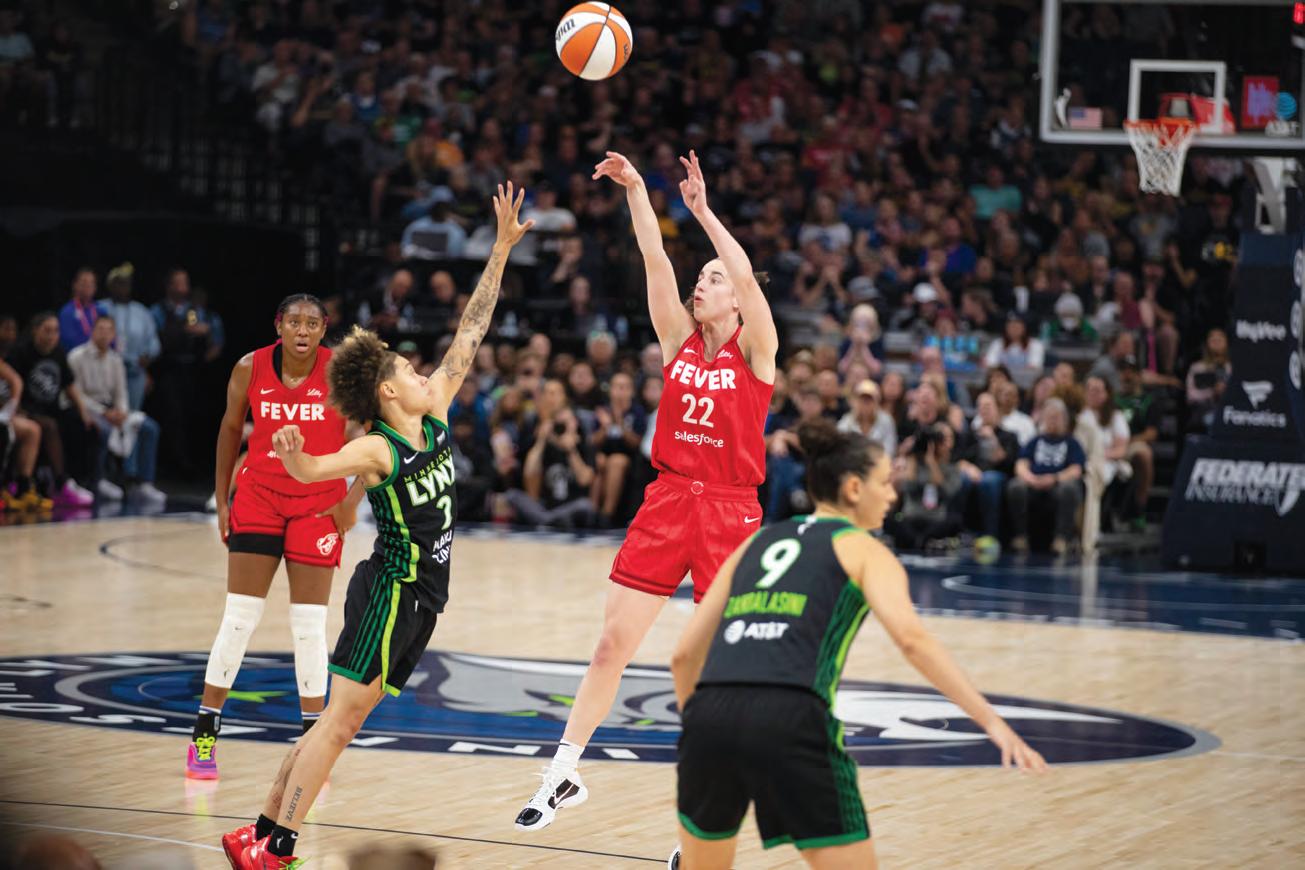
Per USA Today, Clark’s draw with the team’s success in her senior season generated over $3 million in ticket revenue. The “Caitlin Clark effect” has its own Wikipedia page.
“No one forced this on anyone — it wasn’t media-driven,” Christine Brennan of USA Today wrote in a column last May. “It was the fans. They did it. People want to spend their money to see her. They want to buy her jersey. They want to wait in line for hours to get into the building where she’s playing.”
“To all the people that have just poured into me throughout the course of my career, from the people that don’t get any recognition, from our media team to our managers, all of you that have given so much of yourselves to allow me to be who I am, thank you. I can’t say it enough. I wouldn’t be here without all of you.”
Caitlin Clark Former Iowa women’s basketball player
So, prices just to get into Carver-Hawkeye Arena for Sunday’s contest skyrocketed with the ceremony announcement. An initial average of $314 per ticket, according to Eric Nemeth in a release on behalf of ticketing website Victory Live, jumped to an average of $420.
Fans got their money’s worth from the very start to the very finish. Hundreds of fans were already posted outside the stadium hours before tipoff, forming a long line trailing down the block before the doors opened.
“When I went out to shoot, there were already people in the stadium,” Iowa guard Lucy Olsen said. “I was like, ‘What is this? People aren’t supposed to be here yet.’ And then when we came out to warm up, it was so loud already before tipoff.”
Fans poured into the arena immediately to where nearly all seats were taken half an hour before gametime. The magnitude of the day — immortalizing an all-time great Hawkeye combined with a matchup against a top team in the nation — set the stage for such an environment.
“I’m really impressed with the atmosphere here, the love for women’s basketball,” USC head coach Lindsay Gottlieb said. “We know that [from] the things we’re doing. We get to write our own story but are part of a synergy around women’s basketball that has, in many ways, emanated from here.”
“It’s just a testament to what Caitlin’s done and the direction that the sport is headed in,” USC guard Juju Watkins added. “I’m super grateful to have a part in it.”
That’s what the day was about — showing gratitude for having witnessed arguably the greatest collegiate career across any sport. The jersey retirement was a way for the Iowa women’s basketball program to give thanks, but the turnout for the event was a way for the city of Iowa City to give thanks.
“She’s made huge history here on campus but also across the country and across the world,” Christopher Metsgar, who traveled from his home of San Antonio, Texas, to attend the game, said. “It’s amazing to look around the stadium and see all the young women with number 22, and they see someone that looks like them.”
Caitlin Clark stepped foot in Carver-Hawkeye Arena for the first time without donning her iconic 22 on her chest. The Hawkeye faithful donned it for her instead.
And of all the 22s to be seen in the stands, the most notable one wasn’t seen until after the Iowa-USC game when it was hung up in the rafters — a place where no other player can touch it, or her impact, ever again.


OPINIONS
Stadiums matter more than you think
Going to a sporting event is a magical experience. Thank the stadium.

Jackson Mendoza Opinions Columnist opinions@dailyiowan.com
You wake up. It’s game day. The adrenaline and excitement you have been feeling all week start to sharpen as you put on your favorite player’s jersey. You hop in the car with your friends, primed and ready for the game. Music is blasting, you and your friends predict the score and stats, and life couldn’t be better.
Then you get to the stadium, and the line just to get into the parking lot is a mile long and is not moving.
There goes all that excitement.
I recently attended the AFC Divisional matchup between the Houston Texans and the Kansas City Chiefs in Kansas City, Missouri, and this was my exact experience. It took an hour — which felt more like 50 hours — to get into the parking lot at Arrowhead Stadium. And once we did, it took us another 30 minutes or so to find a parking spot. We finally found a place to park and immediately headed toward the stadium. The only way to get from the parking lot to the stadium was through an extremely narrow tunnel and set of stairs. Thousands of people were simutaneously trying to fit into this little tunnel, which added another 30 minutes to our trek to get inside the stadium.
As soon as we escaped the tunnel filled with Chiefs fans, we met our next obstacle: the lines to get into the stadium. Actually, to describe what we experi-
COLUMN

enced as lines would be mislabeling them.
These were just groups of people all clustered together, hoping what they were standing in was a line. Another 30 minutes added to our trek.
Once we finally made it to our seats, the first quarter had already started, and the Chiefs were in the middle of their opening drive.
Jose Hernandez, a third-year student at the University of Iowa who joined me for this game, explained how the wait times impacted his experience.
“This was my first-ever NFL game, and my excitement was through the roof to see my favorite team. We left early in the morning to get to the stadium and be able
to tailgate, another thing I had never experienced,” Hernandez said. “The lines to get into the parking lot took that away from me and set a negative tone right away.”
However, once I got into my seat and started to watch the game and appreciate how beautiful the stadium looked, my mood changed for the better.
Fans of the Chicago Cubs can probably relate.
They are a slightly above .500 team with no superstar names on the roster. Yet their home games consistently draw in large numbers of fans.
Why is this? Because Wrigley Field is the best sports stadium in the U.S. Part of the reason people go to Cubs games is just
The great impacts and influences of David Lynch
The passing of this generational talent will leave a truly unfillable void within the film industry.

Reese
Thompson Opinions Columnist opinions@dailyiowan.com
Hollywood was struck with the shocking passing of filmmaker and visionary David Lynch earlier this month, who was only 78 years old. He was a once-in-a-lifetime talent, and his work will inspire Americans for future generations.
Lynch’s filmography has become iconic in the world of cinema because of its surreal imagery, eldritch sounds, background noises, and unsettling themes.
suddenly appeared to him. It is so captivating that his ideas come to him just as mysteriously as they appear on the screen.
“Twin Peaks” was a massive step forward for television during the 90s and led to the Golden Age of TV. Shows became more adventurous, and directors took risks after Lynch proved to them that TV could be weird and still rake in immense viewership.
Lynch had a big impact on the TV and movie industry, but those were not the only media that tried to copy his surreal and terrifying visuals and themes. Video games have also been heavily influenced by the Lynchian style. The premise of “Deadly Premonition” is unmistakably similar to that of “Twin Peaks,” and the “Silent Hill” series features characters inspired by “Lost Highway” and industrial settings resembling those found in Lynch’s debut film “Eraserhead.”
to be inside Wrigley Field and experience something they cannot anywhere else.
Last season, the Chicago Cubs averaged a home attendance of 35,922 people, which ranked sixth for attendance out of all the teams in the MLB, according to ESPN. Wrigley Field has a capacity of 41,649, which means that each game was at least near a sold-out crowd. Here in Iowa City, we have Kinnick Stadium — the quintessential college football stadium. Kinnick has a capacity of 69,250. There are college football stadiums that exceed over 100,000 people, like Ohio State, Tennessee, and Alabama, but that could create more inconveniences than positives. Kinnick Stadium holds just enough people to create a lively and noisy college football experience while not holding too many people. There are multiple parking lot options scattered around campus, which creates less traffic at the beginning and end of games. There is not just one giant parking lot where everybody is leaving all at once. This also allows for different tailgating locations, and every die-hard Iowa football fan loves to participate in a good tailgate. Once inside Kinnick Stadium, you can partake in incredible traditions like the Hawkeye Wave after the first quarter and spelling out “Iowa” after every touchdown. All of these factors are what make going not just to an Iowa football game memorable but going to Kinnick Stadium iconic.
A high-quality and efficient stadium does so much for the viewing experience of fans going to watch their favorite team they might not even realize in the moment. Next time you go to a sporting event, take note of what each stadium does well to improve your overall experience.
No one should be afraid to report a crime
Undocumented immigrants in our community are much more likely to be the victims of violent crime.

Every crime has a victim.
As the county attorney, one of my most important jobs is to hold perpetrators of violent crime accountable and find justice and safety for their victims.
Lynch had a big impact on the TV and movie industry, but those were not the only media that tried to copy his surreal and terrifying visuals and themes.
The word Lynchian is used to describe tones, visuals, sounds, and themes that mirror those found in Lynch’s filmography. It also describes the dark underbelly of something seemingly pure and harmless, which is a recurring point of investigation in Lynch’s work. We see this in his fourth film “Blue Velvet,” where a college student discovers a world of sex and drugs in his picturesque community.
Lynch used his childhood memories of suburbia in the Pacific Northwest as inspiration for his hit show “Twin Peaks,” which aims to uncover the truth behind Americana. “Twin Peaks” also features the fan-favorite dream sequence, wherein special agent Dale Cooper sits down in a game show sort of style with deceased woman Laura Palmer, whose mysterious death is the focus of the show.
This scene features wacky voices, eerie sounds, and the infamous red room setting that leaves viewers feeling uneasy. Many would describe Lynch’s work as dreamlike — arguably the best understanding of the dreamscape of any other filmmaker.
“Catching the Big Fish,” Lynch’s book on meditation, tells us how he was able to come up with such a groundbreaking scene. Apparently, Lynch was in a parking lot and touched a hot car, and the red room
Ryan Anderson, a fourth-year film student at the University of Iowa, discussed his experience watching Lynch’s “Blue Velvet” in one of his classes.
“We discussed how well he created a disturbing setting and how that can captivate audiences by feeling anxious, uncomfortable, and uncertain for the characters,” Anderson said.
Aside from Lynch being a successful and groundbreaking filmmaker, he was also a quirky optimist who helped Americans through the 2020 pandemic with his lighthearted YouTube weather reports.
He also participated in the 2014 Ice Bucket challenge, using iced espresso instead of water while attempting to play “Somewhere Over the Rainbow” on his trumpet.
His YouTube career doesn’t end there, though. Lynch posted a 20-minute recipe and tutorial video on how to make quinoa. Even this short film captures the surrealist tones and imagery his other films exhibit. A fan-made memorial for Lynch was started at Bob’s Big Boy in Burbank, California. Archivist and historian Kate Fox has been slowly disassembling the shrine in hopes of preserving it. The reason fans decided to use this chain restaurant as a space for remembering and mourning Lynch is because of how much time he spent there in the early years of his career.
The LA Times stated that early on in Lynch’s career, he would come to Big Boy every day at 2:30 p.m. to order a milkshake and several cups of coffee. Lynch does not have a star on the Hollywood Walk of Fame, so fans and community members chose his favorite restaurant as the place to honor him and his memory. Lynch was beloved by many, and his presence will leave an unfillable hole in the filmmaking industry.
Jami Martin-Trainor | Executive Editor
Columnists: Cole Walker, Muskan Mehta, Abigail Jones, Caden Bell, Reese Thompson, Grace Dabareiner, Julia Anderson, Aaron El-Kadani, Kennedy Lein, Jackson Mendoza
Editorial Board: Jami Martin-Trainor, Marandah Mangra-Dutcher, Jack Moore, Stella Shipman, Muskan Mehta, Charlie Hickman
COLUMNS, CARTOONS, and OTHER OPINIONS CONTENT reflect the opinions of the authors and are not necessarily those of the Editorial Board, The Daily Iowan, or other organizations in which the author may be involved.
EDITORIALS reflect the majority opinion of the DI Editorial Board and not the opinion of the publisher, Student Publications Inc., or the University of Iowa.
A few years ago, I met Lily, who had recently discovered her daughter was being sexually abused by her father, “the perpetrator,” who was a U.S. citizen. Lily had also been severely abused by the perpetrator. When Lily discovered her daughter’s abuse, she faced an impossible dilemma. If she called local authorities for help, the perpetrator would make good on his threat to report Lily’s immigration status. Lily feared that reporting the abuse would make her daughter less safe because, if Lily got deported, she could not protect her. Lily was especially vulnerable because she was an undocumented immigrant. The perpetrator brought her to the U.S., and she overstayed. At the time of the abuse, Lily was a reliable and valued employee for a local business. Her daughter was born here, attended school, and was part of our community.
When the perpetrator started abusing her daughter, Lily knew she needed help. She called the police, and officers immediately brought her and her daughter to safety. The officers never asked about their immigration status. The school community rallied around Lily and her daughter, and local nonprofits helped them access counseling and treatment. The perpetrator was arrested, prosecuted, and sentenced to prison.
Cases like Lily’s are common in Johnson County. Undocumented immigrants in our community are much more likely to be the victims of violent crime, not the perpetrators. Perpetrators of violent crimes use their victims’ undocumented status as leverage so they can continue the abuse.
I bring Lily’s story to the community’s attention because, as county attorney, I want people to understand when anyone in our community is afraid to report a crime, everyone in our community is less safe. I am exceedingly concerned that the threats and actions coming from Washington will deter victims from reporting violent crime. As a result, victims, many of them children, will be subjected to unmitigated abuse, serious injury, and even death.
Protecting the safety and the rights of every person in our community is the top priority of the Johnson County Attorney’s office and our local law enforcement partners.
If someone you know is a victim of a crime, please don’t be afraid to report it. My office and local law enforcement are here to help. In fact, local law enforcement is prohibited from asking for or collecting “any information from a victim of or witness to an alleged public offense or from a person reporting an alleged public offense, including the victim’s, witness’s, or person’s national origin, that is not pertinent to the investigation of the alleged public offense,” as stated in Iowa Code.
Mug club makes its way to Roxxy
Roxxy’s new ownership launched a mug club promotion to bring in new business.
Evan Watson Assistant News Editor evan.watson@dailyiowan.com
New traditions tend to start small. The busyness of col lege living can leave little time for enjoyment. So, free time must often be curated.
In a college town, from the perspective of a venue enter taining music or nightlife, this becomes a competition for that time. Businesses must market to survive, with most “local” establishments in the U.S. spend five to 10 percent of their revenue on marketing.
As college is a very choice experience, local businesses, primarily bars, are well-aware they are playing — and pay ing — for time.
Deep into the semester, downtown and ped mall bars have lines running out the door and then some. Addition ally, most of the time, patrons will end up paying at least $5 to even set foot in the place, resulting in an immediate, and at least partial, recoupment of the dollars spent to bring students to the door with costs for entry that can often exceed $10 to $20, or much more on the busiest nights.
But now, only two weeks into the semester, a new tradi tion is starting small.
On the Friday before the University of Iowa’s start of classes this semester, Roxxy launched a new mug club pro motion that has run for the past three weeks. The concept is a dead ringer for mug club, which The Brothers Bar and Grill franchise has been running for almost 30 years.
Patrons buy a plastic mug for $5 inside the bar that, on Friday nights for Roxxy, can be filled with a variety of drinks at a reduced price, such as $1 wells and $2 Captain Morgan drinks, among others.

The deal is one of a variety of business strategies that the Harmonic Hospitality Group, which recently bought the Roxxy franchise among other local Iowa City brands like Stuffed Olive and Double Tap is employing as part of its rebranding.
A shot wall also lines the back of the bar, featuring 98 differently themed shots for customers to choose from, a new addition.
The Roxxy mug club started at the brand’s Cedar Falls location in October 2024. After seeing success, Harmonic Hospitality decided to bring it to the Iowa City location, Vice President of Operations Matt Buffington said. Buffington said the promotion itself is just another one of the brand’s strategies to bring patrons into the bar.
“Once they are full, even if they are running that good of a promotion on Friday, they run out of room eventually.”
Trey Jennings Brothers General Manager
“Any bar wants to fill their space up,” he said.
For reference, Roxxy Iowa City can hold 200 patrons at capacity. Just across the street is Brothers Bar and Grill, which runs its mug club on Thursday nights and sports a capacity of 800, a distinction that Brothers General Manager Trey Jennings said can eventually benefit their establishment on Friday nights.
“Once they are full, even if they are running that good of a promotion on Friday, they run out of room eventually,” he said. Jennings said that, in reality, Roxxy’s mug club has seemingly somewhat impacted their usual business on Fridays, though he added it is too early to declare if there is an observable or lasting impact on patronage.
Starting up these new traditions can be difficult, especially with lingering logistical issues that need to be understood and acted upon. Jennings said the Brothers franchise has run a mug club for decades and said Roxxy
may have to adapt to issues like mug inventory and other employee infrastructure specifics.
“Over time, I’ve personally learned to know when I need to order more [mugs]. That might be something they’ll need to start thinking about,” he said. “There’s a lot of moving parts with running a promotion like that.”
Those moving parts are the aforementioned customers, who in this case are largely students.
Marketing cannot always stand against preference, and the first few weeks of Roxxy’s mug club is slowly reaching its target audience.
Roxxy management declined to comment on the new mug club.
Roxxy hosted its third mug club event Friday, Jan. 31. By 10 p.m., students began to funnel in more and more, but just a half an hour earlier, a glance inside from the Pedestrian Mall showed an empty bar.
There seemed to be an exchange between both Brothers and Roxxy for much of the night once activity picked up, and bar patronage was certainly lower earlier in the semester during freezing temperatures.
Patrons walked out of Roxxy, dumped their mugs out, and crossed the brick to Brothers. Some Brothers patrons made the B-line to Roxxy, instead.
The two bars now seem somewhat similar, but some bargoers were quick to say Roxxy’s new program is the opposite of good news.
“A bar offering dollar drinks on a Friday means it’s nearing its end,” UI student Grayson Talaski said. He was out with a group of friends carrying mugs on their way out of Roxxy by 10:15 p.m.
Another UI student, Harry Tobin, had a similar opinion to Brothers Manager Jennings, referring to how the promotion’s newness and Roxxy’s overall recency in the bar scene compared to Brothers is contributing to a slow start.
“Brothers has a bigger atmosphere and environment,” he said. “So, there are going to be more people in there.”
More enthusiastic was a group of customers who were looking forward to more opportunities for a mug club,
POPULAR BARS AROUND DOWNTOWN IOWA CITY
Several downtown bars have started mug club deals.
opposing other students’ ideas of competition between the bars.
UI student Alex Ebrecht said Roxxy’s mug club, like Brothers’, is another event that will bring them and other students out to the bars an additional night. He also believes the drinks Roxxy offers are better than Brothers’. Ebrecht said the Roxxy mug club is a new opportunity that will bring business to the ped mall for sure on both Thursday and Friday nights, even if they themselves can only make it out one night. “If I’m not available on a Thursday, now I can go out on a Friday and get the same deals,” Ebrecht said.
How inflation is impacting Iowa City’s food scene
Restaurants in the area are finding different solutions to combat rising prices.
Isobel Perez News Reporter
news@dailyiowan.com
Jethro’s BBQ has recently captured Iowa City residents’ attention due to the addition of an “inflation fee” on customer bills.
This fee, which the restaurant has since renamed to a “market surcharge,” is a 3.5 percent fee added to a bill to accommodate for the fluctuating market. The hope is the fee will allow restaurants to maintain their current menu prices while still responding to the rising costs of operating a restaurant, as the corporate operation manager for Jethro’s BBQ, Heather Henderson, explained to the Des Moines Register
But extra fees like Jethro’s BBQ’s market surcharge are nothing new.
Mandatory gratuity fees, credit card fees, and delivery fees have all existed for years to compensate for the rising costs of food and labor that restaurants pay for. By December 2024, the average wholesale food price had increased 7 percent from December 2023, according to the National Restaurant Association. The price of eggs has increased by 134.5 percent, fresh vegetables by 27.5 percent, and fresh fruits and melons by 17.3 percent.
There are multiple causes for the rising prices of food items, which Peggy Stover,
an associate professor and director of the Marketing Institute at the University of Iowa, said. Stover cited weather patterns like hurricanes in Florida and flooding in Spain, which impacted the prices of oranges and lemons; the war in Ukraine, which impacted the cost of wheat, a shortage of drivers impacting the supply chain; and the bird flu, which has infected over 147,000,000 poultry since January 2024, according to the CDC, and raised the price of eggs and poultry items.
Stover also discussed the impact President Donald Trump’s mass deportations and tariffs would have on the cost and availability of food items and labor with labor prices being a big determiner of food prices. The labor involved in raising crops and animals will be directly influenced by Trump’s mass deportation with 45 percent of hired crop farmworkers in 2017 being undocumented migrant workers, according to Investigate Midwest.
“Mass deportations are going to hurt a lot of the labor within the agriculture industry,” Stover said. “If the new administration goes through with their tariffs, that’s [also] going to start impacting the prices you’re going to be seeing on shelves. For example, if President Trump enacts a 25 percent tariff on Mexico, that means for anything produced
Some restaurants in the area have taken different approaches in responding to inflation.
[in Mexico] and imported into the U.S., that cost is going to be passed on to consumers.”
But restaurants have already been impacted by the rising prices, and Jethro’s BBQ’s market surcharge is just one response to the price jump.
George Etre, the owner of Formosa Sushi
we try to make them a little bit less,” Castlebury said. “Unfortunately, prices are being raised, so we’re also trying to look at our different food systems and see if we can get our lettuce cheaper from another brand, or if we can get our yogurt cheaper from a different distributor.”
“Because food prices have gone up, but certain items have gone up dramatically, so we’re going to try and mix-and-match to see if we can find items that aren’t as expensive or haven’t risen as much.”
George Etre
owner of Formosa Sushi Bar and Iowa Chop House
Bar and Iowa Chop House, said rising food prices have caused him to raise menu prices, cut staff hours, and switch vendors in the past.
“We’re getting to the point now, though, where we’re actually going to start lowering [prices], even though our food costs haven’t gone down,” Etre said. “We just don’t feel comfortable passing that cost along because we know how expensive it is for people to eat out.”
For Etre, one of his solutions was to research what his restaurants order from vendors so he can ensure he’s purchasing items at their lowest prices and reimagining his restaurants’ menus.
“Next month, we’ll put out a new menu,” Etre explained. “Because food prices have gone up, but certain items have gone up dramatically, so we’re going to try and mix-and-match to see if we can find items that aren’t as expensive or haven’t risen as much.”
Similarly, Josh Silver, the owner of Nodo, said he had to adjust menu prices after the COVID-19 pandemic.
“Prices got raised during COVID,” Silver said. “We waited a little, then we redid our menu, and I made sure all the prices were what they needed to be. We try not to [raise prices] too often.”
It’s not just local restaurants and cafes that are affected by the rising food prices, as Sara Castlebury, the manager at the UI’s Eckstein Medical Research Building Cafe, said. University Dining is also feeling the effects of the spike in food costs and is navigating these issues by observing how restaurants are responding and using this as a model.
“We try to either match them in prices or
And while the costs of food and labor are rising, Castlebury said that so far, this has not affected how many students the UI is hiring to work in its dining facilities.
“I know that [University Dining] is looking into shifts that people are covering to see where we need to cut back on shifts or add shifts,” Castlebury said.
Stover agreed with the response from restaurants and cafes, stating that it’s a tough dilemma to maintain a profit while also satisfying customers.
“The restaurant industry, like the grocery industry, have very thin profit margins. If the labor increases or if the price for material increases, it’s going to have a detrimental impact on them,” Stover said. “As far as what restaurants can do, is reconsider portion sizes, making them smaller to where it doesn’t have such an impact on profitability.”
Stover said she couldn’t say whether “inflation fees” would become a popular trend amongst restaurants, but as Silver commented, customers at Jethro’s BBQ seem to agree if it does become a trend, restaurants should be transparent with customers.
“I don’t have an issue with [inflation fees] as long as it’s transparent,” Silver said. “I was brought up that you give the price, and that price should pay for all those things.” Silver explained how he understood restaurants have to take care of themselves and the people they hire, to which Etre shared similar sentiments.
“Restaurants, in general, is very tough, so everybody’s struggling,” Etre said. “So, please don’t take offense against these restaurants if they are trying to cover some of their costs.”
How Trump’s economy could impact Iowa
Experts
say President Trump’s plans for the economy could raise inflation.
Mia O’Connor-Walker Politics Reporter news@dailyiowan.com
Local business owner Kris Kass fears President Donald Trump’s economic policies may negatively impact her businesses.
Kass, part owner of Bread Garden, Joseph’s Steakhouse in Iowa City, and Reunion Brewery in both Iowa City and Coralville, said Trump’s proposed planned tariffs — a tax on imported goods that can be passed onto consumers — could harm business owners. While the tariffs on Mexico and Canada have been delayed at the last minute, the agreement is temporary.
“If we increase tariffs on Mexico, then you’re talking about further issues with produce prices, which directly affects our grocery store and all of our businesses,” Kass said. “There isn’t a restaurant in town that doesn’t order produce of some nature.”
In January, Kass received notice from her distributor that delivery prices will be rising. Though Kass is hesitant to blame Trump’s policies for this as it’s only the beginning of his administration she said it does reflect the volatility of prices in the food market.
Kass said higher produce prices, leading to higher distributor prices, will negatively impact her businesses. She said small local businesses like her own are the most at risk, as they don’t own their distributors like larger companies including Walmart or Target do.
Kass fears these higher prices will make it harder for smaller businesses to compete.
It isn’t just Kass who fears prices could rise under Trump’s administration. Experts, business owners, and farmers fear Trump’s plan for tariffs, among other key economic priorities, could result in the very inflation for which he lambasted former President Joe Biden.
Under Biden, prices rose by 20 percent, becoming a focal point of the Republican party and voters alike.
In an election where voters’ number one concern was economic conditions, Trump’s campaign platform focused on economic policies targeting tariffs, oil production and exports, tax cuts, and mass deportations. Trump has promised these policies will result in steadily decreasing prices and restore economic power to a nation that he has described as, “in serious decline.”
On Trump’s first day in office, he signed an executive order directing his cabinet officials to use every tool at their disposal to reduce inflation, though the move is largely seen as symbolic.
“I will direct all members of my cabinet to marshal the vast powers at their disposal to defeat what was record inflation and rapidly bring down costs and prices,” Trump said during his inaugural address. “We will bring prices down, fill our strategic reserves up again right to the top, and export American energy all over the world.”
But some experts feel otherwise. University of Iowa economists Hennadige Thenuwara and Anil Kumar said they expect inflation to increase because of Trump’s policies.
Thenuwara, whose research encompasses the role of government and economic systems, said that going into the election, voters were concerned about the high cost of living. Trump’s plan, which he claims will lead to steadily decreasing prices, appealed to these concerned consumers.
“He appealed to the suffering of the masses,” Thenuwara said.
Now, though, neither Thenuwara nor Kumar believe Trump’s plans will relieve consumers from financial stress but rather think they will ultimately cause inflation.
Kumar said these inflationary policies, particularly tariffs, will ultimately harm consumers, especially those with less spending power.
“Lower income houses will be disproportionately affected because they spend a larger share of their income on consumption,” Kumar said.
Iowa City business owner expresses concern
Kass said in addition to Trump’s trade policies, his tax policies may also impact her business.
She said her concern is that Trump’s tax policies will create a tax system that benefits the wealthy while being disadvantageous to the middle and lower classes. This could result in the middle class losing spending power, impacting her customer base, which includes students from the UI.
“This is one of the largest enrollment classes since COVID. So, that’s always good,” Kass said of the UI, a key driver of Iowa City’s economy. “That means more people in town, more people spending money. But if all of those people, or you know, 85 percent of those people, have to retrench their spending, that affects all of us in the downtown and that’s very concerning.”
Despite these fears, Kass remains hopeful. She said it’s too early to tell what the effects of Trump’s economic policies will be and that her businesses will just have to roll with punches for the time being.
Kass said she hopes the economy allows people and businesses to flourish, and she hopes that Trump’s economic policies don’t get in the way of this goal.
“It’s concerning, and we want everybody

to flourish. As a business owner, you’re concerned, but as a human being, you’re also concerned,” Kass said.
Economic experts predict higher inflation
Neither Kumar nor Thenuwara believe Trump’s proposed plans of cutting taxes, imposing tariffs on foreign nations, and enacting mass deportations will help the American consumer.
Kumar explained tariffs work by raising prices on imported goods, which is cause for concern, as the U.S. imports more goods than any other nation.
Kumar said economic policies like tariffs create winners and losers in the economy with domestic producers and protected industries like steel benefiting and industries reliant on imports like automobile manufacturing being harmed. The greatest loser, Kumar said, will be the consumers.
In addition to harming consumers, Kumar said another risk of tariffs is retaliation from foreign governments, resulting in a trade war where foreign nations respond to the imposition of U.S. tariffs by placing a tariff on goods that the U.S. exports. Kumar said agriculture is particularly vulnerable in these trade wars.
“Generally, these retaliatory tariffs hit U.S. farmers very hard,” Kumar said.
During Trump’s last administration, his tariffs against China — the largest importer of U.S. soybeans — resulted in a trade war that led to lower prices and revenue losses for U.S. farmers.
In response to Trump’s tariff plans, grain futures on the Chicago Board of Trade have already decreased, with corn futures decreasing by 1.5 percent, soybean futures decreasing by 1.1 percent, and lean hog futures decreasing by 0.4 percent.
Beyond tariffs and deportations, Trump plans to extend the Tax Cuts and Jobs Act, which was initially signed into law by Trump in 2017. This is a move that the U.S. Sen. Chuck Grassley, R-Iowa, supports.
In his floor remarks regarding his support of Trump’s Secretary of Treasury nominee on Jan. 27, Grassley spoke in support of the extension of the Tax Cuts and Jobs Act, highlighting what he perceives as a threat to the middle class were it not renewed.
“And we all know in this body, the biggest tax increase in the history of the country can happen to the middle class even without a vote of Congress, because the 2017 tax bill sunsets at the end of this year,” Grassley said.
Kumar, however, said the extension of the 2017 Tax Cuts and Jobs Act is another key pillar of Trump’s economic policy that could be inflationary.
While aspects of the act, such as the child tax credit and simplifying the tax code, have had positive effects, Kumar said the net effect of Trump’s tax cuts is an increase to the federal debt and a loss of government revenue. Upon the passing of the Tax Cuts and
Jobs act, the Joint Committee on Taxation
estimated the act would amount to a revenue loss of $1.3 trillion over 10 years. Kumar said these tax cuts will primarily benefit the wealthy, and the increase in the federal debt will ultimately result in higher inflation. These effects, he said, will worsen income inequality.
“The bottom line is that extending these tax cuts will further deepen income inequality while adding substantial pressure to federal deficits,” Kumar said.
Realistically, Kumar said the most Trump’s economic plans may achieve would be a modest boost to the economy, which Thenuwara notes could also be the result of technological innovation as opposed to government policies.
Brooke Rollins, Trump’s nominee for head of the Department of Agriculture, said at her confirmation hearing on Jan. 23 that the USDA is prepared to provide financial aid to farmers who may be hurt by a trade war. While Lehman agrees this would be necessary, he said that this kind of government support hasn’t managed to be sufficient in the past.
“The last time tariffs came into effect, farmers experienced lower prices for what we sold,” Lehman said. “We were experiencing extreme financial losses, and the trade compensation payments unfortunately did not make farmers whole.”
“If these inputs are imported from other countries, that tends to raise the price of the products that we have to buy to grow our crops and to grow our lifestyle .”
Aaron Lehman
A fifth-generation farmer in Polk County and president of the Iowa Farmers Union
Kumar said that at least for the beginning of Trump’s term, economic experience will continue to be shaped by Biden- era policies, and it will take time for Trump’s policies to come into effect.
Thenuwara also said it may take time for policies to be felt in the economy but said once policies do come into effect, their impacts will be clear.
“Some of these policies are disruptive,” Thenuwara said. “That might hurt most of the low-income level people. They might lose their jobs. They will have to pay higher prices for goods. Then reality will set in.”
Iowa Farmers Union president fears Trump’s economy plans
Aaron Lehman, a fifth-generation farmer in Polk County and president of the Iowa Farmers Union, said Iowa farmers are bracing for their farm income and farm profitability to deteriorate in the wake of Trump’s economic policies.
One of the most pressing concerns Lehman has is the impact of a trade war on farmers, whom he said were victims of retaliatory tariffs during the last Trump administration’s tariff policies against trading policies.
Lehman said though export-heavy farmers are the most vulnerable to these retaliatory tariffs, all farmers are vulnerable, as they have to import at least some of their input costs like fertilizer, equipment, and seed.
“If these inputs are imported from other countries, that tends to raise the price of the products that we have to buy to grow our crops and to grow our lifestyle,” Lehman said.
Another policy that risks harm to the agricultural industry is Trump’s plan to enact the largest deportation of immigrants lacking permanent legal status in U.S. history. Immigrants lacking permanent legal status make up around five percent of the U.S. labor force but are almost 50 percent of the agricultural labor force.
Thenuwara said he doubts Trump’s policy of mass deportation will be achieved to the extent that he claims. However, he said if Trump were hypothetically successful in his deportation plan, it would have serious economic repercussions, notably in the agricultural and meatpacking industries.
“If that happens, then they’ll hurt most of the low-end agricultural products and meatpacking. We’ll produce at a much higher cost, which will increase the cost of living,” Thenuwara said.
Thenuwara said the increased cost of producing agricultural products resulting from deportations would increase the need for importing goods, which raises concerns about tariffs.
“If we don’t produce it here, whatever is coming from Mexico will have even higher prices due to tariffs, so we’ll be hit twice,” Thenuwara said.
Lehman said while he understands the need for immigration reform, the disruption mass deportations would cause in the agricultural labor force would raise production costs for farmers.
Lehman said this will not only make it more difficult for family-sized farmers to survive, but it will ultimately lead to higher food prices and may result in a less secure food system.
“Food will be less safe unless we can have a reliable labor situation,” Lehman said.
Lehman fears the damage Trump’s economic policies will do to the farming industry will place rural Iowan communities at risk of economic devastation.
He noted that on Jan. 15, Iowa-based agricultural manufacturer Kinze announced layoffs, shortly followed by one of Iowa’s largest farming cooperatives, Landus, announcing layoffs on Jan. 17. These layoffs follow the John Deere layoffs in August.
Lehman said these layoffs are a sign of how reduced farm profitability resulting from Trump’s economic plans have a domino effect in Iowa’s economy and harm communities.
Speaking to this lost farm income, Lehman said, “It’s going to impact not just the farm, but it’s going to impact the businesses on Main Street. It’s going to impact our churches in our rural communities. It’ll impact our school districts. All of our community institutions will feel the impact when farm income drops.”
UIHC performs its first-ever infant heart transplant
Wesley Peterson, the patient, was just eight months old during the operation.
Jacob Calvin News Reporter news@dailyiowan.com
According to a 2024 U.S. News report, the University of Iowa Health Care Medical Center is in the top 10 percent of hospitals in the nation in specialties such as heart surgery, lung surgery, and orthopedics.
By the numbers alone, patients are in good hands, but a health crisis doesn’t discriminate by location. It frightens anyone not to have control over their future or their health.
But patients like eight-month-old Wesley Peterson, who started his year off receiving a new heart, exemplify how to face this overwhelming fear: taking it one smile at a time.
Wesley’s long medical journey began at four months old on a family trip to Utah. After simple symptoms including a rash and a fever, his parents, Spencer and Julia Peterson, began noticing more concerning signs, such as his fingers turning shades of purple and white.
Doctors in Utah began to find aneurysms everywhere in Wesley’s body. They then deduced that the four-month-old was suffering from polyarteritis nodosa, or PAN, an autoimmune disease that enlarged his coronary arteries, which soon developed clots. Essentially, Wesley was having a continuous heart attack.
His doctors decided to send Wesley to UI Health Care Stead Family Children’s Hospital, where his care team, consisting of Rabia Khan, Gary Beasley, and Michelle Staron-Ehlinger, began work immediately.
They first attempted to rid his clots through medication, which proved unsuccessful. Matters became frighteningly worse when Wesley’s heart stopped altogether.
“Once we got to Iowa, everything kind of just hit the fan,” Julia Peterson said.
Wesley’s care team performed CPR for 30 whole minutes before they were able to put him through extracorporeal
“He was a fighter, and he definitely found ways to be happy, even with all the things that were going on.”
Spencer Peterson Wesley Peterson’s father
membrane oxygenation, or ECMO.
“ECMO is, of course, a great tool that we have and a life-saving measure, but it’s not something that we would want patients to be on for a long time because there are high risks associated with ECMO,” Khan said.
These high risks include long-term cognitive and neurological deficiencies. Wesley was able to avoid these, but the care team needed to find something to assist his heart while they thought of long-term solutions.
They decided to put Wesley in a ventricular assist device, or VAD, which helped to keep his blood pumping through a series of tubes.
Yuki Nakamura was tasked with performing the procedure that placed the VAD and, later, the transplant.
Surprisingly, the VAD proved to be the most difficult step for Nakamura.
“I’m pretty sure VAD implantations in a patient one week after a myocardial infarction in such a small pediatric patient has never been done,” Nakamura said.
After calling fellow pediatric heart surgeons for their advice, Nakamura found the confidence to successfully implant the VAD.
While a VAD is usually reserved for the left side of the body, Wesley’s heart was in such critical condition that his care team surgically connected both sides.
“What is challenging for us in pediatrics is that a lot of the devices that we use are designed for adults, and we have to make them work for kids,” Beasley said. “You can imagine, the device designed for a grown person doesn’t necessarily fit into a four-month-old.”
The care team was able to put Wesley on a kid-friendly designed VAD called the Berlin Heart. For his first month on the device, Wesley was intubated in bed.
“We had to find new ways of comforting,” Julia Peterson said. “Instead of picking him up, the most I could do is have my arm under his head and just kind of hold him that way, even though he’d still be in bed.”
After a month, Wesley was able to be seated in a chair with the device. Julia and Spencer Peterson were grateful for the change.
“It had been over a month since we’d held him, and there was a point where we probably didn’t think we were going to get to hold him again,” Julia Peterson said.
Whether he was being held by his parents or his care team, Wesley was all smiles.
“He was a fighter, and he definitely found ways to be happy, even with all the things that were going on,” Spencer Peterson said.
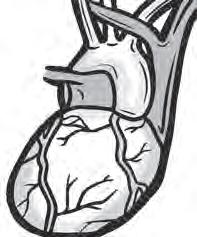
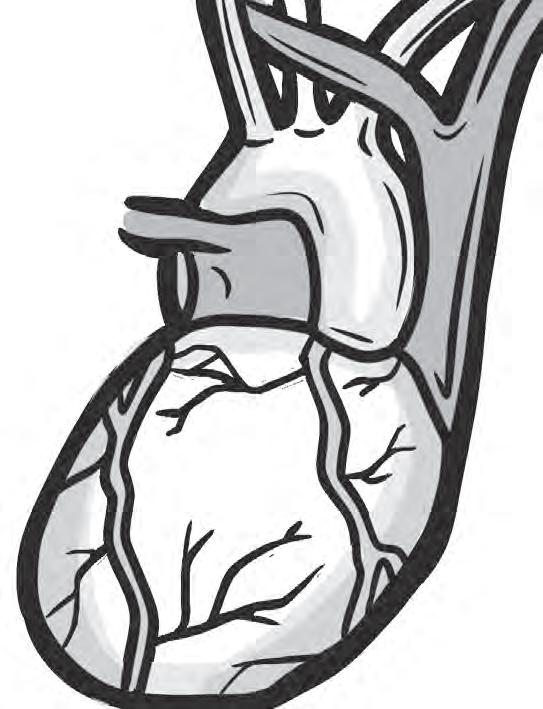
Now came the care team’s long-term solution: a heart transplant. While the Petersons kept their hopes tempered and expected the procedure to happen in March, UIHC was able to secure a heart in time for the holidays.
Nakamura was tasked with the transplant surgery that lasted close to 12 hours.
“Because of the disease, the PAN, his vessels were very abnormal and fragile, and during the surgery, the vessels actually started to get torn,” Nakamura said. “So, I had to do some extra steps to make sure that we did not have significant bleeding.”
Wesley’s transplant was a success.
“It’s crazy to me to see how much he really did need a new heart,” Julia Peterson said. “As happy as he was on the heart pump, he’s just 100 times more happy and energetic, and he’s just thriving with it. And it’s just incredible to see.”
Staron-Ehlinger was not only amazed at Wesley’s resilience throughout but his change in energy after the transplant.
“I mean, he’s just the happiest boy,” she said. “The
Iowa City VA expanding its Women’s Clinic
The estimated deadline for the project’s completion is fall 2026.
Jacob Calvin News Reporter news@dailyiowan.com
As it stands, women are the fastest-growing group in the veteran population. According to the U.S. Department of Veteran Affairs, women accounted for four percent of the veteran population in 2000. By 2040, they are projected to account for 18 percent.
Public Relations Director of the Iowa Department of Veterans Affairs Karl Lettow believes this number will only increase.
“As more women can serve, the more women veterans there are going to be,” he said. “Therefore, the need for treating them on the VA side is probably going to grow and commensurate with their percentage of the actual force.”
The Iowa City VA Health Care System will address this need head-on, as the VA’s main hospital will add 27,500 square feet and two floors to the Women’s Health Clinic to accommodate its growing number of female veterans. The estimated deadline for completion is fall 2026.
“The new space will provide four exam rooms. Each one of them will have their own bathroom,” Women’s Clinic Manager Bonnie Konkowski said. “We need a procedure room for things like IUDs, colposcopies, those kinds of things, so this particular room will be very helpful.”
Konkowski believes the additions will help strengthen the Women’s Health Clinic as a one-stop shop for all women patient health needs from services like primary care, gynecology, breast health services, psychology, and social work.

minute he woke up mildly, like a little bit from sedation, he was smiling around his ET tube ... This is the epitome of why we do what we do, is to work with families like this and see results like this.”
As for the future, Wesley will be on medications for the rest of his life to suppress his immune system from rejecting the new heart. Outside of medication, Wesley’s future is unrestricted.
“In a few years from now, if you were to go up to a playground where Wesley is running around playing, you wouldn’t be able to pick him out as the heart transplant kid from anybody else on that playground,” Beasley said.
For Spencer Peterson, Wesley’s health journey proved to be a new experience. As a UIHC medical student, he usually finds himself on the other side of the bed.
“I had already decided I wanted to go into pediatrics and work with kids, and seeing all the success and the impact that the care from Wesley’s team was able to make just solidified my choice of wanting to work with kids because I’ve seen how big of an impact it can make,” he said.
Konkowski also hopes the health clinic will help address an unintentional national disparity of health care treatment of men and women that has formed over the years.
“Men are often perceived as very stoic and pain-tolerant, whereas women may be perceived as more sensitive and more likely to report pain, but maybe less likely to be taken seriously for cardiovascular disease,” she said. “They just don’t correlate heart health with women.”
Konkowsi also emphasized the disparity in medical research, estimating only 39 percent of clinical trials include an equal male-to-female ratio. An equal
guidelines, the FDA did in 1993, there is still a big research gap even today.”
Lettow shared his approval of the United States Congress giving more attention and funding to women veteran’s health-related issues.
“The contributions that they made are right on par with their male counterparts,” he said. “We all serve together. It’s all one team. A bullet doesn’t know gender.”
University of Iowa first-year Ella Wertz shared her perspective on the expansion. Wertz is currently in the ROTC program and drills with a National Guard unit.
“The contributions that they made are right on par with their male counterparts. We all serve together. It’s all one team. A bullet doesn’t know gender.”
Karl Lettow
Public Relations Director of the Iowa Department of Veterans Affairs
ratio could prove beneficial, as some medications are effective with one gender and disagree with the other.
“Back in 1977, females of child-bearing age were removed from clinical research studies because some of those drugs caused some serious birth defects,” she said. “So, even though they updated their
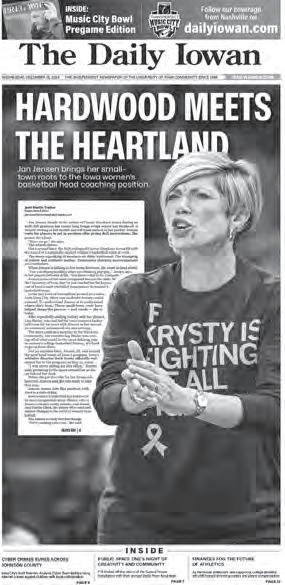
“I definitely think [the expansion] is great,” she said. “ I know in the past, female representation in guard Army Reserves has just been pretty low, so the fact that it’s expanding to help other women veterans, especially those with disabilities, is a really good step in the right direction.”


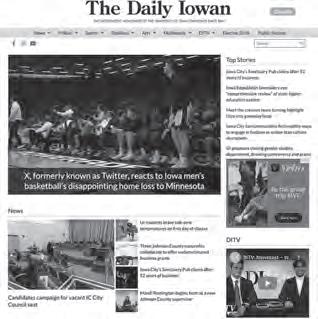
HAWKS TOPPLE THE TROJANS

The Iowa women’s basketball team defeated No. 4 USC inside a sold-out CarverHawkeye Arena on Feb. 2. Following the game, a ceremony took place to retire No. 22 in honor of former Iowa guard Caitlin Clark. With 14,998 fans in attendance, the Iowa Hawkeyes have offically played in front of 32 consecutive sold-out home games marking the longest streak in the nation.
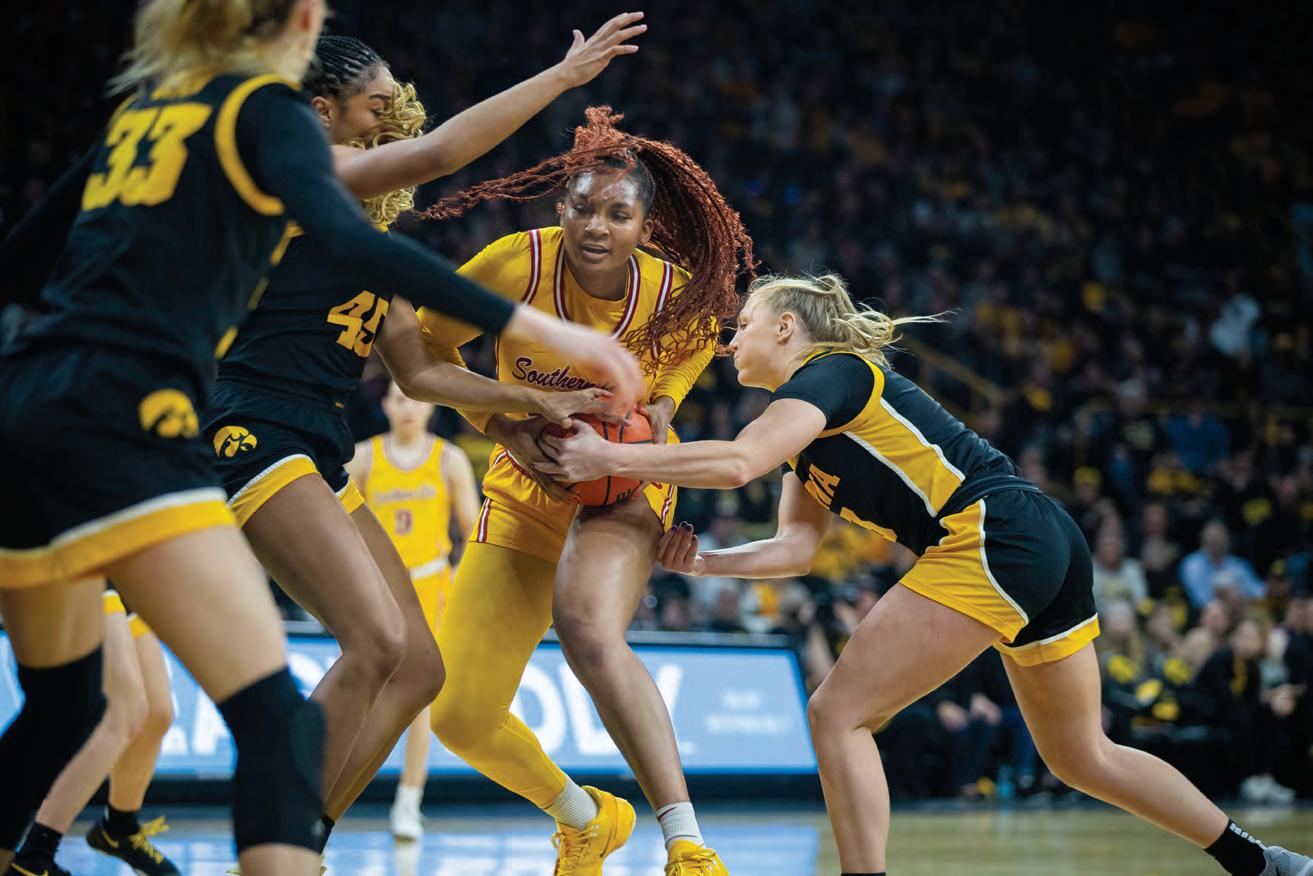
Emma Calabro and Isabella Tisdale | The Daily Iowan (Top) Hannah Stuelke wins jump ball during a women’s basketball game between Iowa and No. 4 USC at CarverHawkeye Arena on Feb. 2. The Hawkeyes defeated the Trojans, 76-69. The sold-out game marked Iowa’s first Big Ten game against the Trojans. (Above) Sydney Affolter wrestles for the ball during a women’s basketball game between Iowa and No. 4 USC at Carver-Hawkeye Arena. Affolter recorded 11 points and nine rebounds in addition to a career-high eight free throws and five steals.
(Beside) Iowa head coach Jan Jensen argues with a referee during a women’s basketball game between Iowa and No. 4 USC at Carver-Hawkeye Arena. Following the game, Jensen spoke alongside former head coach Lisa Bluder on Caitlin Clark’s time at Iowa in commemoration of Clark’s jersey retirement. (Bottom) The Iowa bench reacts to a three pointer during a women’s basketball game between Iowa and No. 4 USC at Carver-Hawkeye Arena. With this victory, Iowa brought an end to the Trojans’ 15-game winning streak.
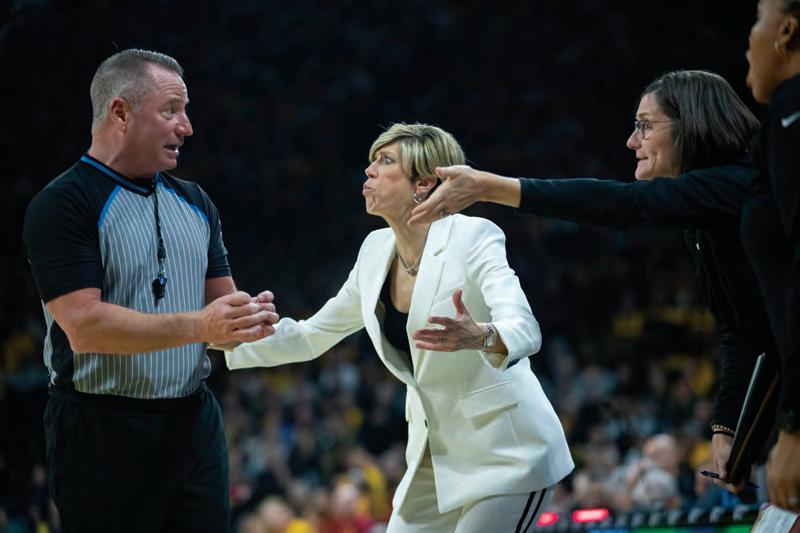
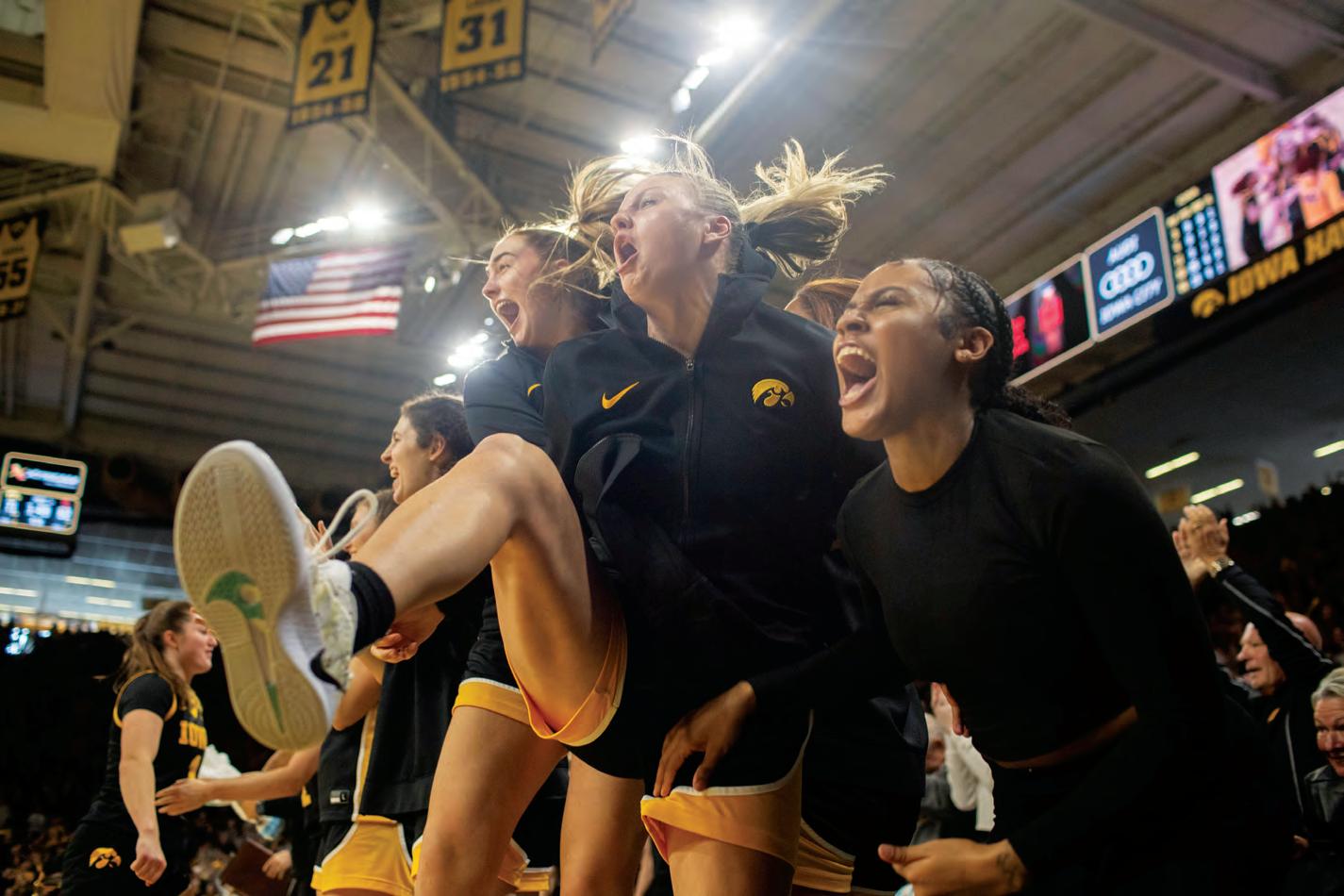
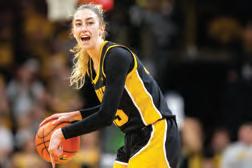
WOMEN’S BASKETBALL
First-year guard rising to the occasion
Iowa women’s basketball player Aaliyah Guyton has risen from injury to intensity.
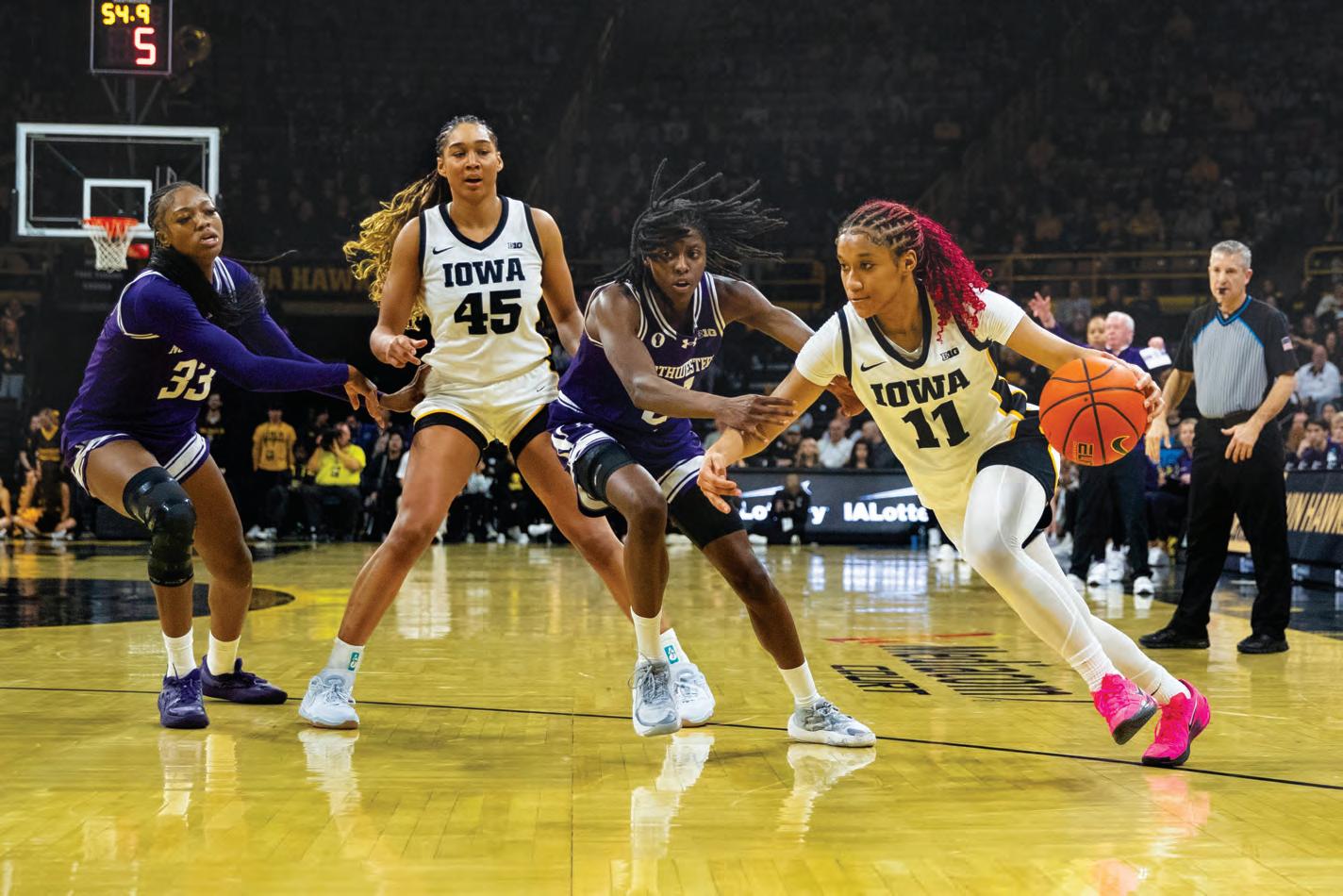
basket during a women’s basketball game between Iowa and Northwestern at Carver-Hawkeye
for 30:31 and had 15 points.
Jack Birmingham Sports Reporter sports@dailyiowan.com
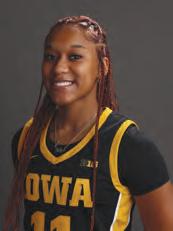
Even in a program with so many new faces, Iowa women’s basketball firstyear Aaliyah Guyton has become a player to watch this season.
The daughter of Indiana Hoosiers All-American A. J. Guyton, the guard has transitioned from a bench player learning the ropes to a starter seeing valuable minutes in crunch time. In
fact, Guyton has risen to the occasion each time her name has been called. She started her career as a Hawkeye with two points against Washington State in front of a sold-out crowd at Carver-Hawkeye Arena on Nov. 24, chipping in two from the charity stripe to contribute to Iowa’s 72-43 win.
Guyton kept moving forward and hasn’t looked back since.
“I’ve always felt like I have been preparing myself to get called off the bench,” Guyton said. “With that time, I always make sure I know what my role is. It’s actually easier to watch from the bench and see what’s going on first, take
a couple of notes in my head, then just go out there and do what I can for the team.”
Some of the first-year’s skills may stem from being the daughter of two basketball stars in their own right. Her mother, Adriana Mafra, played 25 years with the Brazilian National Team and had a career with the Phoenix Mercury. Her father played for Indiana, kickstarting a career that included playing overseas and with the Chicago Bulls.
Most of Guyton’s abilities, however, come from hard work and dedication to the sport. Hailing from Peoria, Illinois, Guyton is one of five freshmen who had
Iowa cheerleading champions safety
Iowa cheerleader Austin Beam’s accident brought attention to the sport’s rules and regulations.
Matt McGowan
Sports Reporter sports@dailyiowan.com
The routine was simple. A roundoff and three back handsprings, finishing with a layout. Hands and feet springing off the ground. An airborne body tight and compact as it effortlessly glided down the pathway.

Iowa cheerleader Austin Beam has performed the sequence countless times. He’s been tumbling ever since he started gymnastics at 11 years old. The Hawkeye cheerleading team had featured the tumbling pass for more than two decades in its “Lone Ranger” performance during basketball games.
But on the night of Jan. 21, a collision between head and hardwood cast an eerie silence across the crowd at Carver-Hawkeye Arena. They had come for an Iowa men’s basketball’s game against Minnesota, but the contest didn’t matter then. Second-year cheerleader Jenna Francois had performed ahead of Beam, and hearing this unusual reaction, turned around to see her teammate and longtime friend laying on the floor, motionless.
“I obviously just could tell Austin was hurt,” Francois
The final move in Austin Beam’s anticipated tumbling pass was a layout. Beam said he lost control and collided with the ground during one of the back handsprings, a move that came before the depicted layout. A back handspring and layout are similar in form, with the main difference being that the athlete’s hands touch the ground during a back handspring.
told The Daily Iowan. “So, my first instinct was to just go up to him.”
Paramedics and other medical professionals arrived on the scene moments later. As the crowd around Beam grew larger, all that could be heard was low music over the speakers and the squabble of walkie-talkies.
“It’s very scary,” Iowa cheerleading assistant coach Ashley Stahr said, who witnessed the scene from the media table on the court. “What happened was a complete and total freak accident. We’ve never seen it. Not to say that it doesn’t happen, but not usually on the performance surface.”
Beam said he doesn’t remember losing control during the back handspring or hitting the ground. He recalled the crowd’s applause as he exited through the arena tunnel in a neck brace and on a stretcher, extending a thumbs up as he disappeared from view. The next thing he knew, he was looking up at doctors from the University of Iowa Hospital and Clinics, where he stayed for three to four hours and underwent multiple tests and scans.
“The precautionary stuff: the neck brace, the, ‘Don’t move, don’t move,’” Beam said. “You kind of always assume the worst.”
THE TUMBLING PASS
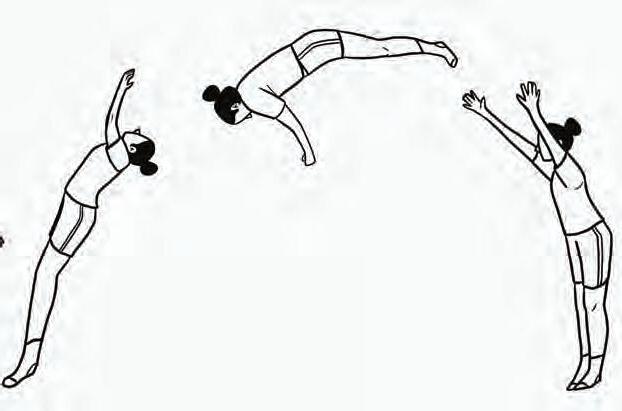

to earn their place on the Hawkeyes roster, newly led by first-year head coach Jan Jensen, assistant to veteran Lisa Bluder for 24 years at Iowa. “She plays defense,” Jensen said, explaining her decision to start Guyton following a 62-57 loss at Illinois on Jan. 9. “She gives me another ball-handling guard. She showed what she can do. I think it’s pretty evident.” Jensen also noted the
WRESTLING
Kyle Parco’s dominance in bout No. 4
The fourth-year Sun Devilturned-Hawkeye has remained vigilant this season. MEN’S
Trey Benson Sports Reporter sports@dailyiowan.com
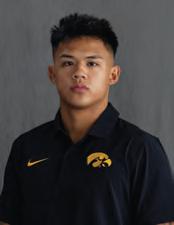
After making the tough decision to trade the dry heat of Arizona for Iowa’s often sporadic weather, Kyle Parco’s vision for the 2024-25 season has remained committed to leading the No. 2 ranked Iowa men’s wrestling squad to a national championship.
Earlier this season, Parco jump-started his career in the black and gold singlet by defeating No. 15 Jadan Abas of Stanford in a decisive 15-0 technical fall victory.
“That first period is always feeling your opponent out. I think in practice, you try to get rid of that in the first period,” Parco said after his match. “You really try to score in that first few minutes and gain a huge advantage.”
The fourth-year’s performance that day was just the beginning of his dominance. The 149-pounder has won his first 13 matches of the season and has solidified himself as a star on an already loaded Hawkeye roster.
While the former Sun Devil has steamrolled through his Iowa career thus far, the success Parco has had this year would not have come to fruition without his time spent in Tempe, Arizona.
Prior to his tenure with Arizona State, Parco spent two years at Fresno State. The athlete, originally from California, spent much of his first year on the sidelines and later decided to redshirt the season. After a year of training, he recorded an impressive 24-4 record during his second season. That success in the cardinal and blue singlet would later translate to maroon and gold, as Parco transferred and joined the Sun Devils. He compiled a staggering 107-18 record in three seasons, including a national fourth place finish at the NCAA championships in 2023.
Now a seasoned athlete, Parco is approaching almost 140 career bouts and leads the No. 2 Hawkeyes in dual starts with 49. His veteran leadership and mentality have helped turn a mere dream of winning a national title into a reality.
The addition of Parco from the transfer portal has proven to be a steal for the Hawkeyes this season and will
Softball
Friday, Feb. 7
Kennesaw State Clearwater, Florida 3 p.m.
Friday, Feb. 7
Tennessee Clearwater, Florida
6 p.m.
Iowa needs to put the right pieces together
The Hawkeyes began the month of January with promise, but problems on both sides of the floor have turned their 2024-25 campaign in the complete wrong direction.

Brad Schultz Assistant Sports Editor brad.schultz@dailyiowan.com
When I last wrote this column back in late December, the Iowa men’s basketball team was in pretty good shape.
The Hawkeyes didn’t have any marquee wins but showed plenty of promise, nearly pulling out huge ranked victories over Michigan and in-state rival Iowa State.
January offered a chance for Iowa to compile wins before facing a grueling February slate, but the Hawkeyes have done the exact opposite. In fact, they aren’t just losing.They are getting embarrassed on a nightly basis.
The Wisconsin game on Jan. 3 proved to be an unfortunate precursor to this ongoing free-fall. The Kohl Center has been a house of horrors for Iowa in recent years, but the Hawkeye faithful felt their squad was ready to take the next step toward a return to the NCAA tournament.
Instead, the Hawkeyes took five steps in the wrong direction, suffering additional road blowout losses to USC, UCLA, and Ohio State. Sandwiched inside those losses was a dismal home defeat to Minnesota, who came into the contest with only one victory in the Big Ten.
Fran McCaffery certainly has had some embarrassing losses during his 15-season tenure in Iowa City, but this month alone he has probably produced a quarter of those defeats, which is not a good sign for a longtime coach.
That brings us to the big picture issue.
WHAT YOU’VE MISSED
Former Iowa women’s basketball phenom Caitlin Clark announced on Jan. 28 she would be donating $22,000 to four Iowa Cityarea nonprofit organizations: University of Iowa Stead Family Children’s Hospital, Coralville Community Food Pantry, Boys and Girls Clubs of the Corridor, and the Iowa-East Central Special Olympics. The news came just days before Clark’s muchanticipated jersey retirement ceremony on Feb. 2 afternoon against No. 4 USC in Carver-Hawkeye Arena that saw her make her return to Iowa City hoops.
“One of my favorite things about Iowa City is the way the community is connected and how everyone supports each other,” Clark said in the Caitlin Clark Foundation’s media release. “It is something I felt during my time here and is important to me that I stay connected with. I am proud to be a part of each of these organizations’ efforts and the meaningful impact they provide for the people of Iowa.” It was also announced on Jan. 30 both Clark and the Indiana Fever would play an exhibition game inside Carver on May 4. Clark formed the organization in October 2023 with the goal of providing and uplifting young children and their communities through education, nutrition, and sports. The buzz around Clark, who wore No. 22 during her Iowa tenure, has been heard throughout Iowa City and will likely increase with the news of the donations.
“Caitlin Clark has not only redefined excellence on the court, but has also inspired countless young athletes to pursue their dreams with passion and determination.”
University
Iowa’s NCAA tournament hopes aren’t totally dead, but they are just about on life support at this point. The Hawks certainly have some chances to earn some big wins with home games against Purdue, Wisconsin, and Oregon on the schedule, but those look like long shots considering how poorly this team has defended and even shot the ball at times.
Every team goes through a down period at some point in the season, but I can’t recall a McCaffery-coached team ever looking this lifeless in these types of winnable games during his entire tenure. Even his 2017-18 team that finished 4-14 in league play fought hard in games where they shouldn’t have had a chance.
The difference? That squad was filled with underclassmen and was expected to have a down season, while this team was supposed
Q&A | CALI LENG
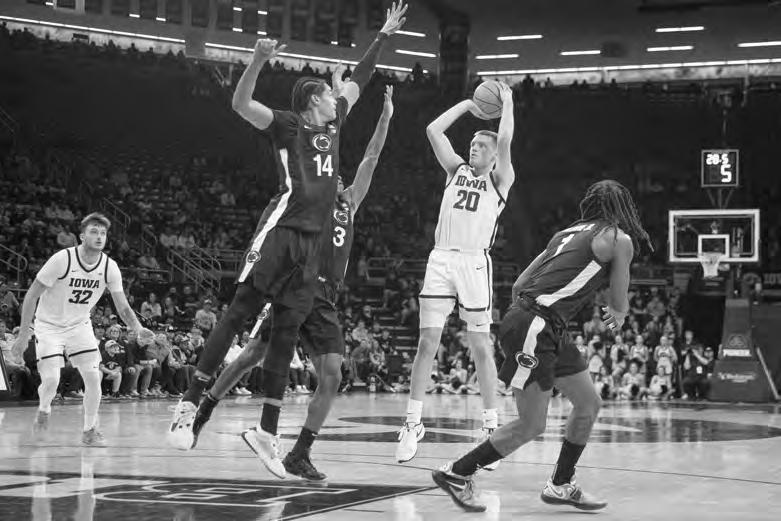
to take the next step forward. It just hasn’t clicked at all this year.
On paper, this is actually a talented roster. Josh Dix and Payton Sandfort, and Owen Freeman have immense potential to be elite players in this league. Drew Thelwell is a stud on both sides of the floor. Brock Harding, Seydou Traore, and Pryce Sandfort have all shown that they are capable of filling in extra scoring gaps when needed.
Dix and Sandfort have plenty of experience under their belts, but they seem to disappear in games far too often. Dix didn’t even record a point in last week’s blowout loss at Ohio State, and most of Sandfort’s points came when Iowa was down big in the second half.
The Hawkeyes are a team that is built to outscore teams with their offense, so when two of their best players don’t show up in crucial moments, that is a major problem. Both of these guys are too talented and valuable to this team to not perform well each and every night.
Defense will always be an issue for a McCaffery-coached squad, but it’s hard not to address how badly this unit has performed this season. I thought this team would have the
Iowa women’s wrestler talks accomplishments and fears
Jackson Miller Sports Reporter sports@dailyiowan.com
The Daily Iowan: What is your favorite accomplishment in your wrestling career?
Cali Leng: I have two. When I was a senior in high school, I won my second state title, and that was a really big moment because it was the first time girls’ wrestling was sanctioned in Ohio. I would also say wrestling in Carver-Hawkeye Arena this year for my first time ever was one of the most electric and exciting moments I’ve gotten to experience in my wrestling career.
If you could travel anywhere in the world with all expenses paid, where would you go and why?
I want to go to Japan. My teammates just got to travel there, and we have some of the Japanese wrestlers in the room now. I want to see the scenery and eat the food. I’d love to go for
wrestling, but I’d also love to go just to be there and experience Japan.
What was your favorite childhood snack?
potential to defend at a high level coming into the year,, but Iowa’s inability to snag rebounds and defend basic ball screens has turned it into one of the worst defenses in the country.
“I think as guards, we kind of try to fight over screen,” Harding said at a press conference on Jan. 20. “Sometimes we hit screens and kind of die down, and that’s on us. That keeps our big guy dragging out a little bit too long, and then guys are open at the rim, and that gets an open kick out for threes, and then kind of just all starts on the ball with me.”
It’s clear the Hawkeyes aren’t afraid to hold themselves accountable for their mistakes, but they just haven’t been able to fix them thus far. Fans have complained about how Iowa is supposedly “checked out” during games, but that’s a statement I’ll never judge.
Iowa has enough horses in the stable to compete in the Big Ten, but its last month of action has proved the exact opposite. It’s hard to fathom the Hawkeyes suffering a losing season, but that idea could turn into a reality if they continue to play this way moving forward.
Unless Iowa turns this ship around, expect more empty seats and apathetic roars at Carver-Hawkeye Arena.
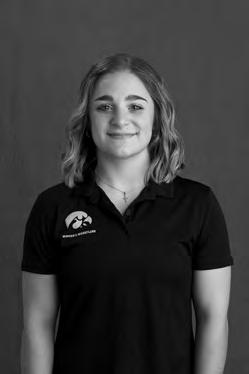
I really like Pop-Tarts and ice cream. My dad also used to make microwave popcorn and put shredded cheese on it and heat it. That was another one of my favorites.
What gets you motivated?
Seeing my teammates do well, whether it’s in practice or competition. For me, every time I’m in the room, that keeps me motivated because I always want to work. I have a hard time not coming in to train and work for myself and my goals.
How many countries have you traveled to, and which is your favorite?
I’ve traveled to one other country. I went to Italy, so I think that’s fair to say that one was my favorite.
Besides wrestling, what is your I like to watch basketball. I’ve gotten to go to a lot of games here. I enjoy watching it because it’s fast-paced, and it’s fun to watch.
What is the best restaurant you’ve ever been to?
There’s a steakhouse back home in Ohio called Hyde Park Steakhouse. It’s really nice, and it has really good lobster macaroni and cheese.
What is your biggest fear and why?
One of the fears that I have is that I won’t be able to look back on my career with fulfillment but with regret. Everything I’m doing now combats that because I try to give my all into everything I’m doing so that I don’t regret anything. That’s something that also motivates me. I don’t want to look back on anything and think I could have done more.

Yes
As the infamous Selection Sunday draws closer and closer, it’s time we had a real discussion about whether the Iowa men’s basketball team can find itself on the right side of the bubble this March. Many “bracketology” publications have the Hawkeyes on the outside looking in when it comes to making the Big Dance. According to TeamRankings, a website that calculates odds and predictions in college basketball, Iowa has less than a 10 percent chance of making this pristine postseason event. This is not ideal, but there is some good news. One of the key factors in improving your resume is gathering as many quad-one victories as possible before the regular season concludes. A quad-one opportunity is determined by both the

location of the competition and the NET ranking of the opponent. Iowa currently has a 0-7 record in these opportunities. But out of the Hawkeyes’ nine remaining games, eight of them are chances to earn quad-one victories and improve their overall resume. Highlighting the remaining schedule are home games against No. 17 Wisconsin, No. 16 Oregon, and No. 7 Michigan State. All of these teams find themselves high-seed hopefuls and can have a direct impact on Iowa’s profile before Selection Sunday, should the Hawkeyes escape with a handful of wins and close games.
With that being said, I believe the Hawkeyes still make a push for a March Madness berth. A majority of the Hawkeyes’ most difficult games will be played at Carver-Hawkeye Arena, where the Hawkeyes are 11-2 and average a blistering 89 points per contest. If Fran McCaffrey can pull out a couple of gritty wins on the road along with protecting home court, the Hawkeyes have a good chance of going dancing one more time — and saving McCaffery’s job as a result.
Watching the Iowa men’s basketball team this year has been rough — rough enough the fanbase is calling for 15-year head coach Fran McCaffery’s firing. An NCAA tournament appearance yet again seems impossible.
The Hawkeyes are what you’d consider an elite offensive team based purely off the numbers. Besides free throws — 17th with 12.3 made free throws, 18th with 18 free throws attempted, and 16th with 68.3 percent shooting from the line — Iowa is near the top of every offensive team statistic.
The defense, however, is a completely different story. And that story explains why this team won’t see the NCAA tournament.
But the Hawkeyes rank 11th with 32.6 opposing shooting percentage, 14th with 7.6 opponent threes
made, 17th with 32.2 rebounds, and 17th with 16.2 opponent assists. Keeping in mind there are 18 total teams in the Big Ten, Iowa sits in 18th with 78.5 opponent points, 18th with 30 opponent field goals made, 18th with 47.7 opposing field goal percentage from three, and 18th with 37.7 opponent rebounds.
The way to win basketball games is to try and outscore the other team. But the teams that win consistently are the ones that stop the other team from scoring. The Hawkeyes don’t do that.
The question shouldn’t concern the NCAA tournament. It should concern the Big Ten tournament first — which looks unlikely when you look at the slew of ranked opponents in February alone. Indeed, Iowa is on par to face five ranked opponents in its next 10 games, providing unfavorable matchups in a critical stretch for its postseason hopes. Now, that doesn’t mean the Hawkeyes can’t pull off a late-season turnaround. But if there’s one thing that’s certain, it’s that this team doesn’t possess the makeup of an NCAA tournament team, let alone the Big Ten tournament.
GUYTON from 1B
guard’s consistency, even after returning to the floor from an injury.
“She’s been the most consistent kid off the bench,” Jensen said. “I haven’t had a ball-handler to be able to handle the press. I’ve had to limit her minutes because she’s coming back. She’s just about full-go. She finishes at the rim, she usually makes you pay at the three, and she plays deep.”
Guyton’s injury, an ACL tear last January, came after her signing with the Hawkeyes but before the knee surgery that kept her on the bench up until the win over Washington State. The firstyear’s return to playing has been a long journey, to the admiration of her teammates.

“A lot of us have been injured and know what that journey is like, but specifically ACL is a really, really long recovery,” firstyear Taylor Stremlow told Adam Jacobi of Hawkeye Beacon. “She was super consistent with that, worked hard every single day, showed up for herself and for our team.”
Although Guyton didn’t see playing time until Nov. 24, Jensen praised the first-year guard early on.
“I’m excited to get Aaliyah Guyton back,” Jensen said during a media day press conference. “She is still not practicing yet, either, and she would be slotted as the backup to Lucy Olsen. I think we have a really solid, great freshman class.”
Following an 85-80 home win over Northwestern on Jan. 28, Jensen expressed admiration for Guyton’s
SAFETY from 1B
Beam was diagnosed with a concussion and a fractured shoulder blade, certainly not the most dire outcome, but still one that has his left arm in a sling and a four to six week recovery timeline before he returns to the sport he loves.
While Beam’s injury gar nered much media attention for its apparent severity at the time, the cheerleader’s accident is a blip on the radar in a sport that, like any, has its potential dangers but prioritizes safety above all else. For Beam and his teammates and coaches, cheerleading isn’t a hobby but a dedication — a honed craft governed by rules and regulations.
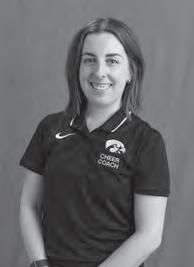
demeanor despite the imperfections of the game as a whole that included 20 personal fouls and 14 turnovers.
“That’s what’s great about Aaliyah — she just takes feedback,” Jensen said. “I don’t think there’s too many kids that right away, when they get cleared, I’m asking her to do what she’s been doing. She’s ebbed and flowed a little bit, but tonight she was a huge key catalyst.”
The first-year’s high school numbers speak for themselves. According to a May 2024 article from ESPN, Guyton was the No. 58 overall prospect as well as the No. 1 player in Illinois in 2024, according to PrepGirlsHoop.
Guyton’s junior year saw her come in as a four-star prospect, averaging 21.6 points, 4.6 rebounds, and 3.8 assists per game. The guard also came to Iowa as the freshman class’ second highest-ranked prospect behind first-year center Ava Heiden, ranked No. 42.
While Guyton’s first two points as a Hawkeye came from the stripe, this season has seen the guard break out as a strong shooter in general.
During the very next game following the win over Washington State, played against Rhode Island in Mexico, the first-year player put up seven for Iowa, going 2-for-3 from downtown and adding in a free throw for good measure. These seven points alone ended up being the difference between the Hawkeyes’ 69-62 win over the Rams and a much closer game.
Guyton’s progress throughout the season has been noticeable, the two free throws against the Cougars representing the tip of the iceberg of what the guard can do.
During the Northwestern game alone, Guyton racked up 15 points, including 3-for-7 from downtown and a perfect
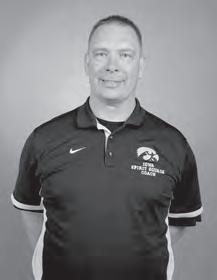
“It’s unfortunate that [the accident] happened in public, because then it reinforces the stigma that cheerleading is unsafe,” Stahr said. “I think that’s kind of where it comes from. It’s mostly like misunderstanding or not knowing exactly what the sport entails and what we do on a daily basis.”
The team practices yearround for two and a half hours, four times a week, in addition to multiple weightlifting sessions. Practice used to be held on the basketball courts of the Iowa Field House, oftentimes sharing the space with people playing volleyball, pickleball, or other activities. Performing with mats dragged onto the hardwood and a Bluetooth speaker in the corner, the space was never really their own.
Practices significantly changed with the opening of the Nagle-Duda Gymnastics and Spirit Squads Training Center on Jan. 29. The $20 million project broke ground in December 2023 with plans to host Iowa women’s gymnastics, dance team, cheerleading
PARCO from 1B
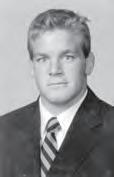
squad, and mascot crew. The new facility features an 85-by-60-foot practice room for the spirit squad with more than 2,000 feet of mat space, not to mention locker rooms and a meeting area. Such a scene was a far cry for head coach Gregg Niemiec, who took over the role 29 years ago a few years after graduating from Northern Illinois University.
“When I first moved here, the team didn’t have any mats, which kind of blew me away being a safety supervisor. I was like, ‘You guys aren’t practicing on mats?’” he said, eyes wide.
Niemiec took swift action, purchasing mats from the athletic department and making them a part of practice. The mats are used for stunts, which are building performances such as a pyramid. For tumbling, the team would utilize the gymnastics facility at the Field House and now rely on the gymnastics room at the new training center, which features tumbling tracks — which are long, trampoline-like platforms — as well as springboards and a foam pit.
Stunting and tumbling have their own respective risks, but each are managed by progressions, Niemiec and Stahr explained. No one just attempts a new skill without going through preliminary steps. There’s even a screening process to join the team. For Beam, he had to submit videos of his performances while others tried out at local clinics the team hosted.
For stunts, a university athletic trainer is always present. The team doesn’t have its own but splits between ones for gymnastics and volleyball. Pyramids can be a maximum 2.5 people tall, meaning one person standing on another’s shoulders with another person halfway above them. Niemiec said the
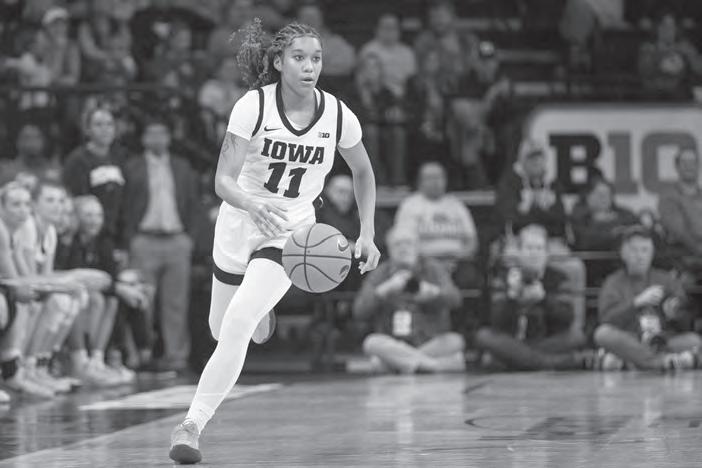
4-for-4 from the stripe. The game was Guyton’s third career appearance with double figures.
“I feel like I stayed the course mentally,” Guyton said after the game, referencing the injury that delayed her start as a Hawkeye. “I do my mental exercises on and off the court. And whenever I feel like I’m backtracking, I have my teammates to help me, too.”
Jensen also praised Guyton’s adjustment from the smaller venues of high school play to the intensity of Carver-Hawkeye Arena and other college arenas.
“Sometimes it’s easy to forget she just got cleared [on] Nov. 26,” Jensen said.
team requires a spotter in the front and back of each pyramid at all times.
“When we’re practicing those, we overdo it,” Niemiec said. “As we’re starting something for the first time, we got, like, the whole team around it that’s not involved, making sure everybody gets up and down safe. As we perfect it more, we’ll pull some of those [extra spotters] off.”
In cheerleading, tumbling occurs on a dead mat, meaning there’s no springs involved. But Niemiec and Stahr explained those conditions are only featured once the cheerleader has a complete grasp of the skill they’re attempting. The cheerleader first tries out the skill with the tumble track and foam pit before removing the foam pit and then transitioning to dead mats. Yet, even with safety protocols, injuries are unavoidable, but their frequency rates fall behind multiple other sports. Cheerleading ranked 17th in injury rate out of 20 surveyed U.S. high school sports during the 2023-24 school year, according to data from the Datalys Center for Sports Injury Research and Prevention, a nonprofit research institute based in Indianapolis, Indiana. Cheerleading’s rate of 1.05 injuries per 1,000 athletic exposures ranked between baseball and boys’ cross country. 68 of the reported 87 injuries occurred in practice.
Many of the protocols Niemiec and Stahr discussed, such as the rule about spotters, are found in the college cheerleading rulebook from USA Cheer, a nonprofit organization established in 2007 to serve as the sport’s national governing body. Its rules are updated each year for clarification and modification purposes. Niemiec and Stahr are both certified as coaches by the organization and are required to follow the rulebook.
Collegiate cheerleading
“The last game she probably played in was in a high school gym with about 50 people, and they were probably winning by 40. Then all of a sudden, you’re in this pressure cooker of which every move that this whole team makes is under fire.”
Guyton’s vocalization on the court will make her a reliable asset for years to come.
“She has that high basketball IQ,” Jensen said after Iowa’s win over Northwestern. “She sees the game, and she’s not one that shies away from any moment. She’s got a really nice way about her, and people don’t just allow her to say it — they want her to say it.”
is divided into two organizations that hold national championships – the Universal Cheerleading Association, known as UCA, and the National Cheerleading Association, the NCA. Iowa competes in the former. While the NCA has a greater emphasis on tumbling, both adhere to the safety regu lations of USA Cheer.
Each August, Iowa attends a UCA camp in the Wisconsin Dells where cheerleaders learn new skills, and coaches attend seminars on rule changes. This trip marks the start of the jour ney to nationals, which occur every January in Orlando, Florida. This was the last com petition Beam competed in before his injury.

“We went in and did our best,” Beam said of nationals. “As long as we’re happy with what we put on the mat, we don’t really care
about the other stuff.” Beam’s injury on Jan. 21 wasn’t his first, and it might not be his last. But Beam has no intention of letting that back handspring mark the end of his journey in the sport. He attended the team’s first practice at the new facility. Francois called him “one of the most passionate cheerleaders I’ve ever met.”
“I think the amount of time all of us spend together really brings us close. With the sport that we’re in, we all have to have full trust in each other, ” Francois said of the team. “Not only does our passion for the sport bring us together, but we all love each other outside of the sport as well.”
likely serve as a prime example for Brands to attack the transfer portal with the same type of aggressiveness during the off-season.
Iowa team have welcomed the senior with open arms. Brands’ philosophy of treating the Hawkeye wrestling squad as a family unit has proven successful thus far, as the trio of transfers Parco, Stephen Buchannan, and Jacori Teemer have recorded only one loss this
season, going a collective 29-1.
“I don’t think it’s transfer versus original,” Brands said.
“This is a team. Everybody wants to be here. That’s what we like. We love guys that want to be here, and they all want to be here.” Brands
“I’ve been in many matches and team situations where a guy or two might lose,” Parco said.
“But I am a skilled veteran, so I think I’m really skilled in that position. Mentally, I am very strong. So, no matter what happens before, I am going to wrestle the same, try to look for a big win, and try to look for points to be scored.”
Despite Parco not starting his career as a Hawkeye, Iowa head coach Tom Brands and the rest of the






OUTMATCHED
The No. 1 Penn State Nittany Lions dominated the No. 2 Iowa Hawkeyes during a men’s wrestling dual at the Bryce Jordan Center in State College, Pennsylvania, on Jan. 31.

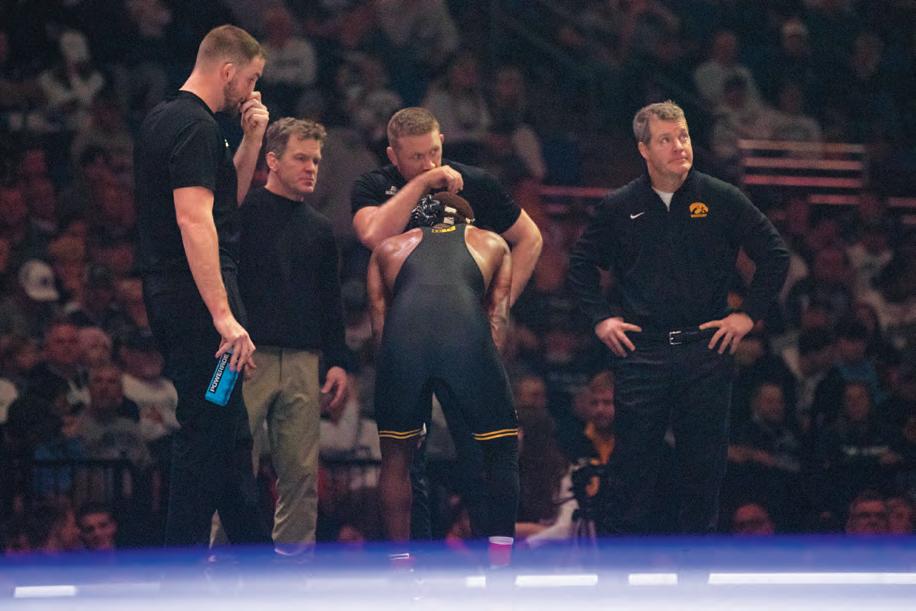
Ethan McLaughlin | The Daily Iowan
(Top) Penn State No. 3 157-pound Tyler Kasak celebrates his 5-2 victory over Iowa No. 1 157-pound Jacori Teemer during a wrestling dual between the No. 2 Iowa Hawkeyes and the No. 1 Penn State Nittany Lions at the Bryce Jordan Center in State College, Pennsylvania, on Jan. 31. The Nittany Lions defeated the Hawkeyes, 30-8. (Above) Iowa coaches instruct Iowa No. 1 157-pound Jacori Teemer during a wrestling dual. The Nittany Lions will look to keep a tight grip on their unbeaten status in their next matchup at home against Michigan on Feb. 7 as Iowa looks to quickly bounce back from this tough loss in their next matchup on the road against No. 25 Maryland on Feb. 2. (Beside) Penn State No. 1 285-pound Greg Kerkvliet looks to an official while on top of Iowa No. 11 285-pound Ben Kueter during a wrestling dual. Kerkvliet defeated Kueter by major decision, 12-1. (Bottom) Iowa No. 1 157-pound Jacori Teemer fights to stay off the mat while wrestling Penn State No. 3 157-pound Tyler Kasak during a wrestling dual. Kasak defeated Teemer by decision, 5-2.

30 8 THE DUAL BY THE NUMBERS

IOWA ONLY WON TWO OF THE 10 MATCHES WITH

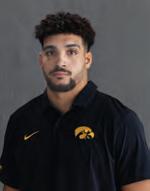
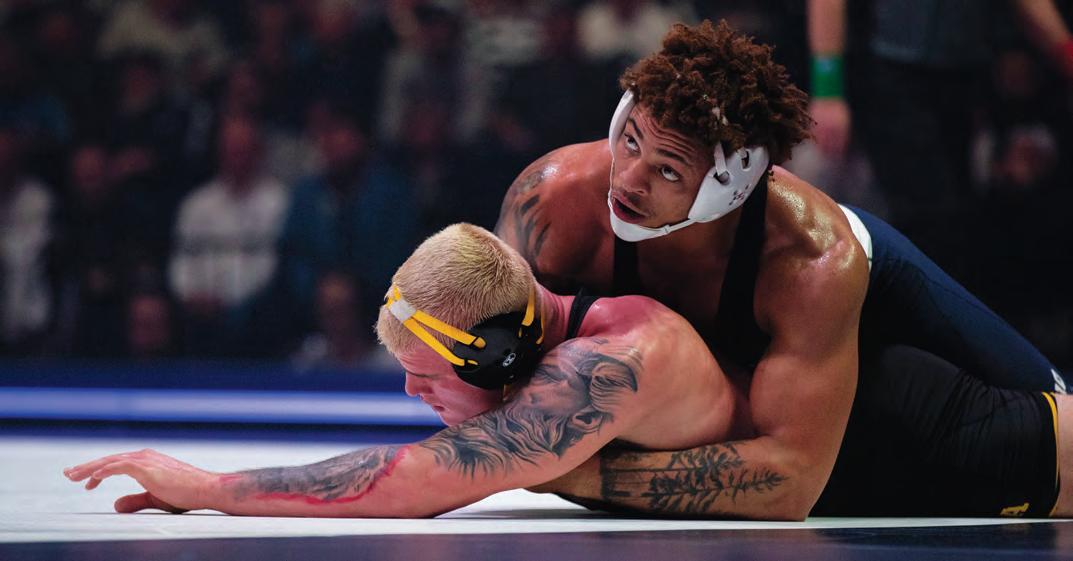
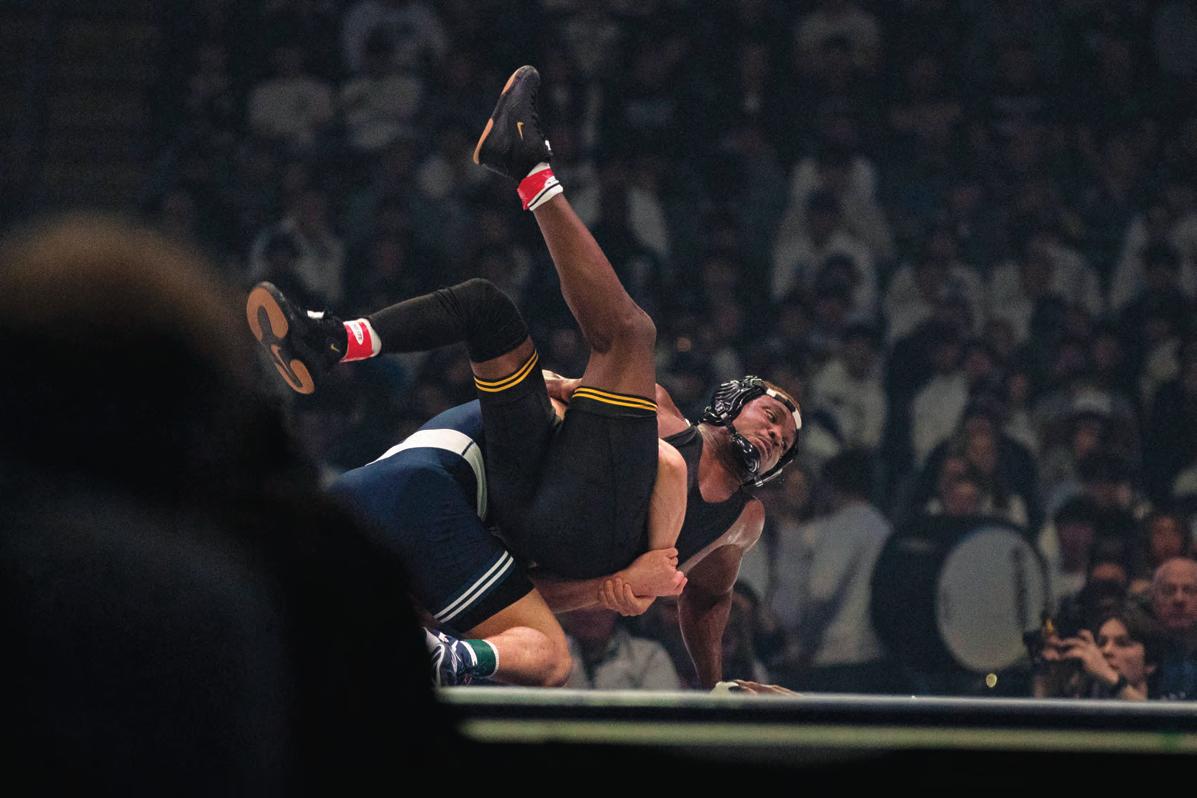



‘Presence’ is a horror movie with a couple snags
A must-see haunted house story through the eyes of a ghost.

Charlie Hickman Arts Editor charlie.hickman@dailyiowan.com
Ghost stories are nothing new to horror films. Everybody has seen a movie about ghosts. “Presence” knows this and challenges the audience’s understanding of what a haunted house movie can be.
Cards on the table, I don’t know if “Presence” is a very good movie. Director Steven Soderbergh — of “Ocean’s Eleven” fame — crafted this single-location movie on a tiny budget. Therefore, some of the performers don’t quite carry the weight of the 80-minute narrative. Some incredibly clunky lines of dialogue from the film’s central human antagonist also greatly drag the film down in its last act.
That said, I had a blast experiencing this in a theater. The film opens with the sale of a gorgeous home to a seemingly typical family. Early on, though, it becomes clear the daughter — played by Callina Liang — is struggling through the major loss of her best friend.
Family politics are at the heart of “Presence,” and we experience them all through the eyes of a ghost who is unsure of why it is haunting the home. To be clear, the ghost isn’t a character that speaks. Rather, the camera adopts the perspective of the ghost’s eyes.
To negate the need to cut, the ghost has a sort of resting spot in the daughter’s closet. Every time the camera cuts, the ghost travels to the closet, and the film cuts to black. When the picture returns, the ghost is once again in the closet at a different time. Each scene varies from 20 minutes to 30 seconds as we see chunks of this family’s deterioration through the spirit’s eyes.
Thankfully, the brief run time and segmented scene structure mean there is not a lot of downtime in the film. The most annoying part of any horror movie to me is when obviously supernatural events occur and characters refuse to admit it. “Presence” dodges this trope.
The story isn’t a mystery; there is no quest to free the ghost or discover its identity. Instead, Soderbergh directs our attention to the secrets family members keep from each other. There’s a sort of dark fun to be had in watching this family collapse and become increasingly paranoid about the spirit in their halls.
Much of the fun is thanks to the excellent camera tricks. One thing about me is, if a movie is doing cool things with a camera, odds are I’ll like it. As the ghost traverses the stairs and halls, the camera glides seamlessly. The effect is spine-tingling. It’s uncanny how inhuman the movements are. During the more intense arguments, the ghost often parks itself between characters and dramatically swivels its eyes between the two. Obviously, this is done to mimic traditional cutting when characters speak to each other, a tactic not possible in this format. Still, it’s amusing to hear a character say something devastating only for the camera — the ghost — to slowly pan 180 degrees to the other character’s reaction. This ghost is a drama queen!
Once the drama between the siblings and the ghost starts to come to a head in the final act, the film began to lose me. There are a few “reveals” meant to tie the ghost’s identity to the family’s tragedy that are entirely predictable and unnecessary. For a film so daring in its construction, it plays the narrative frustratingly safe.
Any horror fan will get a kick out of “Presence,” though. The melancholic family story is compelling, at least for a while, but the central gimmick is what really
Q&A | ISAAC HAMLET




IC battles cabin fever with art
Seasonal depression and cabin fever are rising during these colder months.
Laurel Preston Arts Reporter arts@dailyiowan.com
The promise of spring is nearly here. The chirps of the birds have returned, and it is becoming more socially acceptable to wear hoodies outside instead of full winter gear equipped with long johns, gloves, hats, and the thickest coats you own.
If you are not an Iowa or Midwest native, this warmer weather may seem promising, maybe even uplifting. But beware of the dip back into those days of negative temperatures.
When the weather keeps everyone inside, many fall victim to cabin fever, a restlessness caused by being confined in the same space. Midwesterners are also familiar with seasonal depression born from dreary winters that sprout a new cacophony of irritability, sadness, loneliness, and all those big emotions that come with the season.
Luckily, being in Iowa City means there are plenty of opportunities for art to bring seasonal depression-afflicted patrons out of their funk. Going out in these harsh temperatures may be the last thing you want to do, but art can help ease the mind out of feeling cooped up.
“Going out and viewing art in person, like going to a museum, an art show, or even a concert or play, as opposed to consuming art in a virtual space, allows you to look at the work from different perspectives in an active way,” Kaleb Wiebel, a 2024 University of Iowa graduate, said. “This helps to engage the mind
UI alum delves into fantasy with new book release
Isaac Hamlet discusses the inspiration behind his new novel, the meaning of his pseudonym, and more.
Isabelle Lubguban Arts Reporter arts@dailyiowan.com
Born and raised in Michigan, Isaac Hamlet graduated from the University of Iowa majoring in English and minoring in Latin and journalism. In June 2022, he published his first book, “Light Keeper Chronicle: The Unspoken Prophecy,” and on Oct. 29, 2024, he published his second book, “The Wilderlands.” He has contributed to Little Village Magazine and was an arts and entertainment reporter for the Des Moines Register. From 2013 to 2017, Hamlet worked for The Daily Iowan
The Daily Iowan: What was your biggest inspiration for “The Wilderlands”?
Hamlet: Probably the biggest one was the Latin class that I took in my senior year of high school. We had to read the Aeneid, which [was] a famously unfinished text from Virgil. I had to translate it line by line over a year. I latched on to the idea of language, which you can sort of see in my book. It’s all in English, but it is implied that there are a few different languages spoken, and I played with that. “Something Wicked This Way Comes” by Ray Bradbury was a big anchor point for me where I was like, “Oh, this is how I get this to work on the page linguistically.”
What has your experience as a self-published author been like?
That’s a big question because it’s ongoing, especially this month. This past week, I was listening to the audiobook recording of this, which was the first time I’ve had that done. [For The Wilderlands], I was like, “I know this is a solid text, and I know that I feel good about this.” I’d rather put it out there myself than try to go through all [the work] of convincing people about it and then getting rejected.
What character do you resonate with the most? It has been different characters in different parts of my life. I came up with the first chapter of the book around the time I was wrapping up high school. I wrote the first version of the first chapter and thought, “Ah, that didn’t quite hit with me,” so I didn’t have a strong connection to anyone at that point. When I was writing the first full draft in 2018, I resonated with Knalc, who was the character you’re introduced to at the start of the story who is a person in The Wilderlands. Whether or not it was true, there was an isolation that [he was] experiencing that I resonated with at the time.
Why did you choose the pseudonym “R.E. Bellesmith?” I decided to write under a pseudonym because at the time I was rebranding “Lightkeeper’s Chronicle,” I was working at The Des Moines Register as an arts and entertainment reporter. A lot of my friends have been like, “[Isaac Hamlet] is the perfect writer’s name, you don’t need to change it.” While I was inclined to agree, I had a backlog of nonfiction writing under that name.
and get that dopamine hit that I don’t always get when I passively view stuff through a screen, just on my couch.”
Wiebel’s assertions are more than personal testimony; his experience is reflected in recent discoveries in therapy. Dance, music, theater, and painting have all been used in a new route of therapy that uses art to stand in when words fall short for therapy clients. For some patients, experiencing emotions within a piece of art helps them better articulate what they feel. This type of exposure helps us get that dopamine response we all constantly crave. It helps us think about the world around us, and it helps extend our attention spans so we can go longer without our phones.
Live music is one of the age-old sources of community among fans of the arts. Experiencing live music with other people is a source of emotional liberation and unity that we can’t get from listening to music alone at home.
The neurological boost we get from live music, and live art in general, lasts long after the event is over. Mood improvements and stress relief are factors that last long after leaving a concert venue.
These two benefits alone make live art or performance the perfect answer for stressed out college students seeking relief. If the loneliness of seasonal depression isn’t a problem, though, live arts events can also boost creative productivity.
“Viewing art gives me creative inspiration whenever I’m in a slump, which is good for my mental health because making something works my brain in ways sitting around the house cannot,” Wiebel said.
“Dance was my outlet of expression for 16 years of my life. Through the hardest moments, I was able to let loose and share my feelings without even having to speak,” Olivia Van Fosson-Roelfs, a fourth-year at the UI, said.
Luckily, Iowa City’s arts community is so varied that there is an outlet for people no matter what medium they work in. From concerts at The Englert Theatre, and plays at Riverside Theatre to comedy at AlleyCat Wiebel and Van Fosson-Roelfs have tried it. Take it from these students — there’s no better reliever than live arts.
“You don’t have to think, you literally just let it all out,” Van Fosson-Roelfs said.
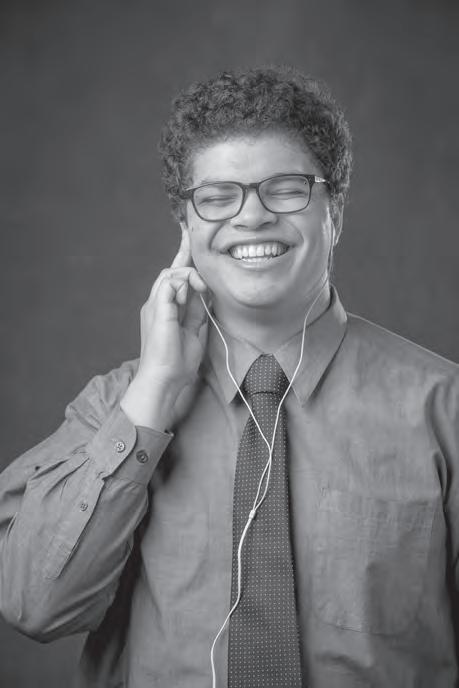
Just to be a little bit cleaner and distinguish myself more, I [wanted to] use a pseudonym. I liked the mystical idea of it, that you could create a name that evokes a certain feeling or sense of the genre you’re writing. R.E. Bellesmith felt sort of fantasy-adjacent. I ended up pulling my sister’s name, Rachel, and my
UI students react to TikTok’s temporary ban
Student content creators fear they may now be missing out on social media trends.
Hussain
Haya
Arts Reporter arts@dailyiowan.com
Kyrsten White Arts Reporter arts@dailyiowan.com
“I didn’t believe it at first, because every year around this time, people say TikTok will get banned. Usually, it doesn’t,” Khushi Patel, a first-year student at the University of Iowa, said.
Patel has been a content creator on the popular, short-form video app TikTok for the past three years.
Ranging from vlogs, mukbangs, and “get-ready-with-me” videos, Patel’s ability to make TikToks was temporarily inhibited on Jan. 19. Among the many twists and turns of the new year, the much-anticipated TikTok ban was officially instituted the night before Donald Trump’s presidential inauguration.
Patel was watching videos on her phone, alongside millions of daily active users on the night of Jan. 19, when the app started to shut down. Users watched as videos slowly stopped loading before the final message was plastered across screens: The app was banned.
But a mere 14 hours later, it was reinstated.
TikTok was originally released September 2016 and quickly became a staple of Gen Z culture. Although it was not the first app with the ability to make short-form content, many people were ready to move over after Vine shut down in early 2017. Some of the app’s initial popularity was thanks to Musical.ly after the two apps were merged.
There were not many issues with the app until 2020, when discussions with the app’s owner, ByteDance, suggested there was a potential security risk. Since it is a Chinese tech company, dozens of lawmakers discussed the potential dangers of it, which led to its eventual ban.
“To be honest, though, I didn’t care as much as I thought I would,” Patel said. “Everyone else around me used TikTok to support themselves, so they were losing a much bigger thing than I was.”
Over 59 percent of U.S. adults under 30 use the app, with more than 7 million users and businesses currently relying on the platform as a means to support themselves. The app is an encyclopedia of resources, trends, pop culture references, and more.
Other than being an avid fan of other
people discovered my account. Now I have about 12,500 followers, and I get PR packages from Buldak Ramen, Arrae supplements, Pixi Beauty, and more.”
While students like Patel still have access to TikTok, some do not. UI second-year student Saranya Paturi and her friend Mia Zdionica deleted the app around a week before it was banned. Now, neither of the girls can redownload it on their phones or use the website version. The Protecting Americans from Foreign Adversary Controlled Applications Act renders all ByteDance apps unavailable in the U.S.
“I was disappointed. TikTok is the basis of all the jokes my friends and I make,” Paturi said. “When we get ready to go to a fancy dinner or have a fun night out, we spend at least 20 minutes making cute TikToks. It’s become a way to bond. Now, I can’t do that on my account.”
It’s unclear when the app will be available to download in the U.S. in the future. To compensate, people have started finding new ways to emulate the same experience of endlessly scrolling through short, quick clips.
“A lot of people moved to this app called RedNote, but I just occasionally use Instagram Reels,” Zdionica said. “Sometimes I go on my iPad if I want to watch TikTok, but I don’t feel the urge to doom-scroll nearly as much.”
The change Zdionica has seen in her screen time is a huge silver lining to the dilemma. TikTok being banned foresees a decline in doom-scrolling, “brain rot” humor, and short, continuous dopamine hits that exacerbate depression and anxiety among teens.
Zdionica and Paturi are both premed students involved in various extracurricular activities. Social media sites often act as a distraction amidst their busy schedules.
“We always have something due or on our to-do list,” said Zdionica. “Every day, though, TikTok seemed to distract me from something that needed to be done.”
Another student, Karen Liu, also said the TikTok ban would help keep her from getting constantly distracted by the app. However, now that it is gone, she finds herself regretting her decision more and more.
“I had so much FOMO. I still have a lot of FOMO,” Liu said. “I’m begging my friends that have it to just go on their phone and scroll for a little bit.”
“We always have something due or on our to-do list. Every day, though, TikTok seemed to distract me from something that needed to be done .”
Mia Zdionica Iowa pre-med student
content creators, Patel has dabbled in posting videos. She has a long and rather comedic history with TikTok.
“I don’t have much of a following, but I gained a little one a little bit in 2022 when I fell off my horse and broke a few bones,” Patel said. “I decided to film a video at the hospital, and that’s when
STUDENT SPOTLIGHT
While she was mostly happy to see it go, she now wishes she had not deleted the app entirely. Liu’s main issue with not having TikTok anymore is how left out she feels. Even though there were lots of people who removed the app after it was reinstated, she still feels like there are trends she might be missing out on.
When TikTok reopened its services,
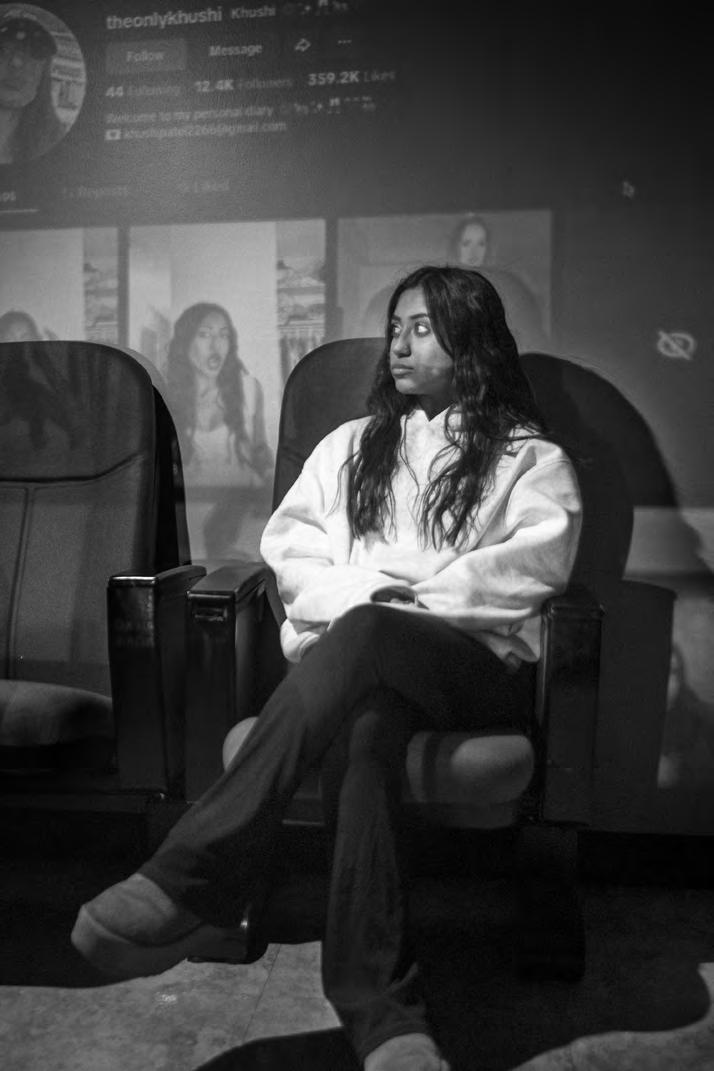
Americans were greeted by a brief message. It claimed the development was “a result of President Trump’s efforts.”
Many UI students were rattled by the message. Paturi, in particular, believes there was an ulterior motive that is not entirely altruistic.
“It was strange. You don’t usually see presidents advertise themselves in this way. Apps, outlets, and that stuff are supposed to remain impartial,” Paturi said. “I don’t think he did it for the good of the nation or for ‘security reasons.’ He did it to look better, and it appeals to younger citizens.”
On his first day in office, President Trump issued an executive order that allowed those with the app to continue scrolling. While it only pushes back the official ban for 75 days, it gives more opportunity for him and his team to look further into its security risks.
Although there are many who adore the app, this long process has left some
users confused as to whether TikTok is going to stay. While many fans are eagerly waiting for the app to come back, the in-between time makes it difficult for some of those who deleted it.
Currently, there are still no promises of the app’s return. Although Trump’s recent claims have made it sound like he is beginning to lean more toward keeping the app, he still states he wants to find a way to remove it from its parent tech company. No one is sure what exactly the future holds for TikTok.
On Jan. 20, when he signed the executive order, Trump claimed he did not see the harm that he once believed the app posed. As it is known, the app is mostly inhabited by a younger demographic of users, which seems to make it less dangerous. With there still being debates behind the scenes as to what will come of the app, some people do not have high hopes. “I really hope it fails,” Liu said.
UI student tells a story of grief with new play
Bridget Dieden’s work on ghostly grief at the Theatre Building grapples with death.
Haya Hussain Arts Reporter arts@dailyiowan.com
On Jan. 31 at the University of Iowa’s Theatre Building, the audience was taken back to the 1940s, as the play “Day Fades Into Night Fades Into Day” made its premiere.
Written by UI student Bridget Dieden, the play follows a couple struggling to conceive a child a few years after their daughter’s death. But it comes with a slight twist: The mother resurrected their daughter, Jillian, as a ghost without the father’s knowledge.
When the couple hires a new maid with a daughter about the same age as Jillian, the daughter discovers her ghost in the playroom, and the pair become friends.
While the play may sound like it has ominous undertones, it covers the topic of grief in a grounded way. The original concept for the play was going to be more on the scary side, as it was Dieden’s workshop piece that was due on Halloween during her sophomore year.
“I was like, ‘Oh, I’ll do something with some kind of ghost in it to match the holiday,’” Dieden said.
This is where her concept of the ghost daughter came from. The story took a
Between being busy with her classes and navigating the logistics that come with planning a play, Dieden does not seem to have many problems with a packed schedule. While many might crumble under the pressure of being spread out, Dieden finds it better to stay busy.
“It helps that I love being busy,” Dieden said. “Standing still is what freaks me out.”
With the help of her desk job at Hancher Auditorium, she manages to stay on top of her assignments and go through the motions of being part of a play production. As it is a student-led project, Dieden, the stage manager, and the director spent several hours figuring out all the little details behind the scenes.
With budgeting, props, and costumes, the three figured out everything that went into the show. Dieden outlined how they have spent hours in meetings so they can schedule everything and keep up with their budgeting requirements. Originally starting as an English and Creative Writing major, Dieden realized she wanted to rejoin the theater scene. It was something she had done during high school, but only as an actor.

“It helps that I love being busy. Standing still is what freaks me out .”
Bridget Dieden University of Iowa student
turn when she decided to create a grief arc, as it is a storyline she always enjoys.
“I just like grieving arcs a lot. I just love stories that are really sad but hopeful in general, kind of like finding hope amidst the darkness,” Dieden said.
“I loved writing, so I figured, ‘Oh, playwriting, perfect. It’s the perfect marriage of those two things’,” Dieden said. “Once I had created this show and fallen in love with some of the characters, so many people helped me. So many people told me to keep going.”
Sara Alvidrez, the director, and Vivian Bonde, the stage manager, are a
major part of the team that has helped Dieden throughout this process. There were many challenges along the way, especially with winter break forcing them all to pause rehearsals.
“Honestly, the actors took it so well and, of course, I, Bridget, and our stage manager kept in touch the entirety of break,” Alvidrez said. “The play was in such good hands, so it’s been a great process.”
Alvidrez and Bonde, both UI students as well, said they have thoroughly enjoyed their experiences while working on the play. Bonde found herself sad to let go of the project as the performances came to an end because of all the fun
they had. “I have never worked with such an incredibly compatible team,” Bonde said. “I think [Dieden] herself just brings an energy into the room that makes it so easy to bring our collaborators together, actors together, our team together.”
Between the three of them and their cast, the play went wonderfully. With three shows, the hard work they all put into it was portrayed through the performances.
“Now I’ve had, for the past month and a half, a team of incredible people that have been helping me through this whole process. Without [them], I would be totally lost,” Dieden said.
Leftover Salmon electrifies the Englert’s stage
The Colorado-based band evoked a thrilling and fun energy that left attendees dancing on their feet.
Hannah Childers Arts Reporter arts@dailyiowan.com
Even while seated in the audience, attendees found a way to dance. Movement was endless, happy, and carefree at the Englert Theatre on Jan. 31 thanks to the powerful energy Leftover Salmon brought to the stage.
From the moment Leftover Salmon stepped up to perform, they had the audience on their feet and dancing in the aisles. It was clear the band was happy to be performing, most notably during the song “Midnight Blues,” an energetic song that pulsed with good energy.
In every song, each instrument featured had a solo. With shrieking rifts on the bass, rhythmic runs on the keyboard, and the heart-pounding with the drums, each soloist received rounds of applause from an enthusiastic audience.
In addition to their lively songs, the band members cracked jokes with each other and the audience, making the show friendly and entertaining.
Leftover Salmon’s banjo player, Andy Thorn, has been with the band since 2010 and has played the banjo professionally for 30 years. Leftover Salmon has existed since 1989 with a rotating set of members who embody a consistent message and energy.
“I was a fan of the band in high school,” Thorn said. “I used to see them play out in North Carolina, so I feel like I’ve known them the whole time.”
Attendee Ella Voloshen had also heard of the band before the show, as the group has performed with several of her friends.
“I know they’re beloved in the bluegrass space, and I’m excited to listen to what they have to perform,” Voloshen said.
Thorn said the band crafted their unique name from a combination of two different bands: Left Hand String Band and the Salmon Heads. Currently, the band consists of six members, led by lead singers and co-founders Drew Emmitt and Vince Herman.
This unique merging also led to the band’s one-of-a-kind sound, a blend of classic bluegrass instruments with the drums of rock.
“They were more of a bluegrass band in the beginning,” Thorn noted. “But [the band] wanted to be able to play the bars and ski towns, so they added drums to sort of rock out at bars. It wasn’t very common at the time.”
Arguably, it is still a unique sound with each instrument played in tandem with the others, adding their energy to the concert. The familiar, fast-paced notes of bluegrass mixed with the high, electric energy of rock pulsed through the floor and pounded in audience members’ chests.
In a profound moment, Thorn, along with lead singers Herman and Emmitt, walked offstage and let the drums, keyboard, and bass guitar continue the show. Even with just those three instruments, the audience continued dancing energetically.
“[I like] their improvisation,” attendee Josh Warner said. This was the second time he’d seen the band perform. “They’re just a fun band to watch and listen to.”
Eventually, when the three did return, they slowly added their harmonies back into the show, bringing the tempo and rhythm back to almost a fever pitch that had the audience gleefully cheering and dancing once more.
“I just hope they have fun and escape the stress of their daily life,” Thorn said.
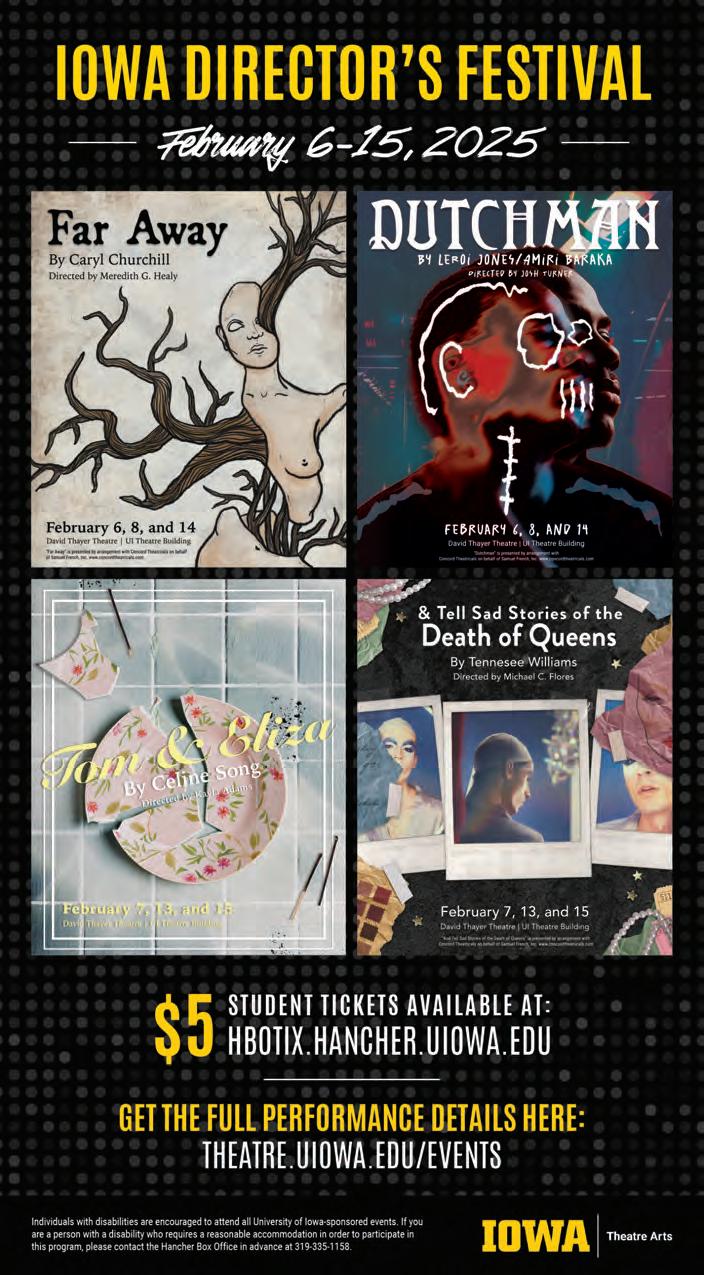

Edited by Will Shortz No. 0101











SETTING UP APARTMENT TOURS
Most rental companies should have an email or phone number that you can reach out to. It’s a good idea to look at an apartment before signing a lease and to start looking early as many students sign leases in the fall or early winter.
Packing Tips
• Keep clothes on hangers in a wardrobe box or into your suitcase with the hangers still attached for fast unpacking.
• Leave your clothing in drawers. Wrap the top with cling wrap to keep everything in place until reach your new home.
• Pack boxes by room: Knowing what box belongs in which room negates the need to go searching for items in other boxes.
• Pack similar items together: Group items like toiletries, kitchen gadgets, and books into separate boxes.
• Label boxes: Clearly label each box with its contents and the room it’s going to.
• Pack fragile items carefully: Use packing material between dishes to prevent them from bumping into each other.
• Document furniture disassembly: Take photos or videos of how to disassemble furniture, including which hardware goes where. For bigger objects like tables or beds, keep all the screws and nails in labeled sandwich bags.
• Pack an overnight bag with anything you will want or need immediately.




Pedestrian Mall creates intersection of campus, city
The Iowa City Pedestrian Mall is the center of nightlife, food, and entertainment for students and residents.
In the center of the Iowa City Downtown District, the Pedestrian Mall provides a space for the community to shop at small businesses, experience local music and entertainment, and eat at unique restaurants and cafes.
Located across the street from the Old Capitol Mall and not far from the Pentacrest, the Ped Mall is a central hub for students. The Ped Mall was constructed in the 1970s, and the outdoor, traffic-free commercial center features a myriad of shopping, dining, and entertainment options, and a playground was recently rebuilt.

Hosting over two dozen dining options, the Ped Mall is home to restaurant and dessert spots including Aspen Leaf Frozen Yogurt, Burger Hall, Dandy Lion, and Formosa. The mall is also the site of Bread Garden Market, which is a locally owned grocery store and eatery.
The Ped Mall acts as the site of favorite nightlife spots like Roxxy Bar, Donnely’s Pub, ReUnion, Joe’s Place, and Brothers Bar and Grill.
Stores like White Rabbit, Textiles, Ragstock, and Revival all make for great shopping options for students looking for fashionable clothing at a low price.
Live music can be heard both inside and out as street musicians fill the air with their riffs and melodies, making for a vibrant city experience. In 2019, the city renovated the mall adding more trees and benches that provide plenty of seating and space to enjoy the open air of the Ped Mall.




It’s time to move into your new apartment. Below is a check list of items you may need.
KITCHEN
• Table and chairs
• Dishes
• Silverware
• Pots and pans
• Baking sheet
• Microwave
• Coffee maker
• Blender
• Toaster/toaster oven
• Food storage containers
• Dish towels
• Oven mitts
• Dish soap/dishwasher detergent
LIVING ROOM
• Couch
• Coffee table or side table
• Television and tv stand
• Lamp
BEDROOM
• Bed, dresser, nightstand
• Sheet set
• Comforter or blanket
• Mattress pad
• Pillows
• Clothes hangers
• Desk
BATHROOM
• Shower curtain
• Bath towels
• Hand towels
• Toilet paper
• Body wash/shampoo/
conditioner
• Shower curtain liner
• Shower curtain hooks
• Toilet scrubber
• Toilet bowl cleaner
• Plunger
MISCELLANEOUS
• Laundry basket/hamper
• Laundry detergent
• Multi-purpose cleaner
• Sponges
• Hand soap
• Kleenex
• Light bulbs
• Vacuum cleaner
• Broom and dustpan
• Trash can(s)
• Trash bags
• Batteries
• Power strips


